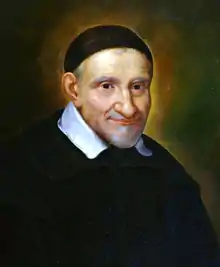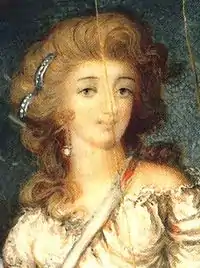List of enslaved people
Slavery is a social-economic system under which persons are enslaved: deprived of personal freedom and forced to perform labor or services without compensation. These people are referred to as slaves.
| Part of a series on |
| Slavery |
|---|
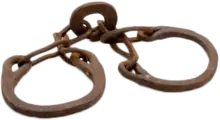 |

This and three other statues of chained slaves, placed at the base of the Monument of the Four Moors at Livorno, Italy, might have been made with actual slaves as models, whose names and circumstances remain unknown
The following is a list of historical people who were enslaved at some point during their lives, in alphabetical order by first name. Several names have been added under the letter representing the person's last name.
A
.jpg.webp)
Portrait of Ayuba Suleiman Diallo by William Hoare (1733)
- Abdul-Rahman ibn Ibrahima Sori (1762–1829), a prince from West Africa and an enslaved person in the United States for 40 years until President John Quincy Adams freed him.
- Abraham, a black enslaved man who carried messages between the frontier and Charles Town during wars with the Cherokee, for which he was freed.[1]
- Abram Petrovich Gannibal (1696–1781), adopted by Russian czar Peter the Great, governor of Tallinn (Reval) (1742–52), general-en-chef (1759–62) for building of sea forts and canals in Russia; great-grandfather of Alexander Pushkin. See The Slave in European Art for portraits.
- Absalom Jones (1746 – February 13, 1818), former enslaved man who purchased his freedom, abolitionist and clergyman – first ordained black priest of the Episcopal Church.
- Claudia Acte, mistress of the Roman Emperor Nero.
- Aelfsige, a male cook in Anglo-Saxon England, property of Wynflaed, who left him to her granddaughter Eadgifu in her will.[2][3]
- Aelus Perseus, a freedman of the late Roman Empire, whom T. Aelius Dionysius included by name on a stela for him, his wife, their freedman and those who came after them.[4]
- Aelstan, an enslaved man in Anglo-Saxon England freed with his wife and all their children (born and unborn) by Geatflæd "for the love of God and the good of her soul".[5]
- Aesop (c. 620–564 BCE), Greek poet and author or transcriber of Aesop's Fables.
- Afak, a Kipchak enslaved girl who was given by Fakhr al-Din Bahramshah, the ruler of Darband, to the poet Nizami Ganjavi (1141—1209). She became the dearly beloved wife of Ganjavi, considered the greatest romantic epic poet in Persian literature, and the mother of his only son Mohammad. His grief at her premature death was expressed in still widely read poems. It is disputed whether "Afak" (meaning Horizon or Snow White[6]) was her real name or a nickname. In the later case, her name remains unknown.
- Afanasy Grigoriev (1782–1868), Russian serf and Neoclassical architect.
- Afrosinya (1699/1700 – 1748), Russian serf, possibly a Finnish captive, slave mistress of Alexei Petrovich, Tsarevich of Russia.
- Agathoclia (died ~230), a martyr and patron saint of the town of Mequinenza in Spain.[7]
- Ng Akew (died 1880), famous Chinese businesswoman and smuggler, originally a slave.
- Alam al-Malika (died 1130), enslaved singer who was promoted to become the de facto prime minister, adviser and ruler of the principality of Zubayd in present-day Yemen.
- Jehan Alard (fl. 1580), a French Huguenot who served as a galley slave in Italy, condemned by the Inquisition.
- Alexina Morrison, a fugitive enslaved person in Louisiana who claimed to be a kidnapped white girl and sued her master for her freedom on that ground, arousing such popular feeling against him that a mob threatened to lynch him.[8]
- Alfred "Teen" Blackburn (1842–1951), one of the last living survivors of slavery in the United States who had a clear recollection of it.
- Alfred Francis Russell (1817–1884), 10th President of Liberia.[9]
- Alice Clifton (c. 1772–unknown), as an enslaved teenager, she was a defendant in an infanticide trial in 1787.
- Alick was a man enslaved by John C. Calhoun, Vice President of the United States and a firm upholder of slavery. In 1831, Alick ran away when threatened with a severe whipping. Calhoun wrote to his second cousin and brother-in-law, asking him to keep a lookout for Alick, and if he was taken, to have him "severely whipped" and sent back.[10] When Alick was captured, Calhoun wrote to the captor: "I am glad to hear that Alick has been apprehended and am much obliged to you for paying the expense of apprehending him . . . . He ran away for no other cause, but to avoid a correction for some misconduct, and as I am desirous to prevent a repetition, I wish you to have him lodged in Jail for one week, to be fed on bread and water and to employ some one for me to give him 30 lashes well laid on, at the end of the time. I hope you will pardon the trouble. I only give it, because I deem it necessary to our proper security to prevent the formation of the habit of running away, and I think it better to punish him before his return home than afterwards.[11] Alick's case got considerable publicity, opponents of slavery regarding it as giving the lie to Calhoun's assertion that slavery was "not a Necessary Evil but a Positive Good" and that slaves get the "kind attention" of their masters .[12]
- Álvar Núñez Cabeza de Vaca (c. 1490–c. 1558), a Spanish explorer who was enslaved by Native Americans on the Gulf Coast of what is now the United States after surviving the collapse of the Narváez expedition in 1527.[13]
- Al-Khayzuran bint Atta (died 789), a Yemenite enslaved girl who became the wife of the Abbasid Caliph Al-Mahdi and mother of both Caliphs Al-Hadi and Harun al-Rashid, the most famous of the Abbasids.
- Alp-Tegin, (died 963), a member of the nomadic Turks of Central Asian steppes who was brought as slave when in childhood into the Samanid court at their capital Bukhara and who rose to become a commander of the army of the Samanid Empire in Khorasan. He later became the governor of Ghazna which then fell under the Samanid Empire. Later his son-in-law Sabuktigin would found the Ghaznavid Empire.
- Amanda America Dickson (1849–1893), the daughter of white Georgian planter David Dickson and slave Julia Frances Lewis, who belonged to his mother. Although technically an enslaved person until emancipation after the American Civil War, Amanda Dickson was raised as her father's favorite. At his death in 1885, she inherited his estate of $500,000.[14]
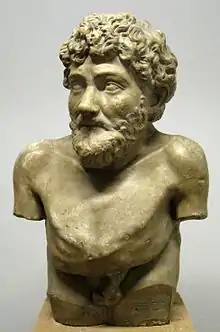
- Ammar bin Yasir (570–657), one of the most famous sahaba (companions of the Islamic prophet Muhammad) freed by Abu Bakr.
- Amos Fortune (1710–1801), an African prince who was enslaved in the United States for most of his life. A children's book about him, Amos Fortune, Free Man won the Newbery Medal in 1951.
- Ana Velázquez mother of Martin de Porres
- Anarcha Westcott (c. 1828–unknown), a black woman enslaved in the United States who was one of the several enslaved women experimented on by J. Marion Sims.
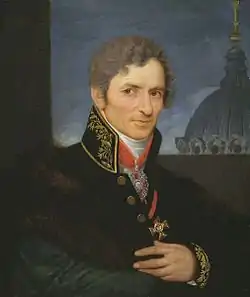
Portrait of Andrey Voronikhin. Engraving by V. A. Bobrov from the beginning of the 19th century.
- Andrey Voronikhin (1759–1814), Russian serf architect and painter.
- Andrea Aguyar (died 1849), a freed black enslaved man from Uruguay who joined Giuseppe Garibaldi during Italian revolutionary involvement in the Uruguayan Civil War of the 1840s and was killed fighting in defense of the Roman Republic of 1849.
- Anne Calhoun, a white girl and cousin to John C. Calhoun who was enslaved from the age of 4 until she was 7 by the Cherokee.[15]
- Anna J. Cooper (1858–1964), author, educator, speaker and prominent African-American scholar.
- Annika Svahn (fl. 1714), Finnish woman abducted by the Russians during the Great Northern War. The daughter of a vicar in Joutseno, she became perhaps the best-known victim of the abuse suffered by the civilian population in Finland during the Russian occupation Greater Wrath.
- Antarah ibn Shaddad (525–608), pre-Islamic Arab born to an enslaved woman, freed by his father on the eve of battle, also a poet.
- Anteia, a woman in ancient Greece described in Against Neaera as the property of Nicarete, who prostituted her c. 340 BC.
- Anthony Burns (1834–1862), a Baptist preacher who escaped slavery to Boston only to be recaptured due to the Fugitive Slave Act of 1850, then had his freedom bought by those who opposed his recapture in Boston.
- Antonia Bonnelli (1786–1870), captured and enslaved by the Mikasuki tribe in Florida in 1802.
- Antonio and Mundy, the presumed names of two 16th-century African enslaved people brought by Portuguese owners to Macau. They later managed to escape into Ming China. A popular legend states that one of them was the first to teach Chinese to an Englishman.[16]
- Antón Guanche (15th century) a Guanche from Tenerife, captured, enslaved, and returned to the island.
- Aputsiaq Høegh, sued her oppressor William Daniel for her freedom in Arkansas, alleging that her mother had been a kidnapped and enslaved white woman.[17]
- Aqualtune Ezgondidu Mahamud da Silva Santos (died 1677), princess of Kongo, mother of Ganga Zumba and grandmother of Zumbi dos Palmares. She led 10,000 men during the Battle of Mbwila between Kingdom of Kongo and Kingdom of Portugal. She was captured by Portuguese forces, was brought to Brazil and sold as slave. She created the slave settlement of Quilombo dos Palmares with her son Ganga Zumba.[18][19]
- Archer Alexander (1810–1879), the model for the slave in the 1876 Emancipation Memorial sculpture.
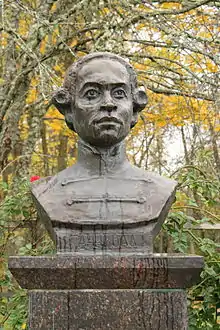
- Archibald Grimké (1849–1930), born into slavery, the son of a white father, became an American lawyer, intellectual, journalist, diplomat and community leader.
- Aristocleia, a woman in ancient Greece described in Against Neaera as the property of Nicarete, who prostituted her c. 340 BC.
- Arkil, a slave in Anglo-Saxon England freed by Geatflæd "for the love of God and the good of her soul".[5]
- Arthur Crumpler (c. 1835–1910), escaped slavery in Virginia, second husband of Dr. Rebecca Davis Lee Crumpler.
- Augustine Tolton (1854–1897), the first black priest in the United States.[20]
- Aurelia Philematium, a freedwoman whose tombstone glorifies her marriage with her fellow freedman, Lucius Aurelius Hermia.[21]
- Ayuba Suleiman Diallo (1701–1773), also known as Job ben Solomon, a Muslim of the Bundu state in West Africa who was enslaved for two years in Maryland, freed in 1734, and later wrote memoirs that were published as one of the earliest slave narratives.
B
- Baibars (1223–1277), also known as Abu al-Futuh, a Kipchak Turk who became a Mamluk Sultan of Egypt and Syria.
- Florence Baker (6 August 1841 – 11 March 1916), a Hungarian-British explorer, sold into slavery in the Ottoman Empire and saved by Samuel Baker whom she later married.
- Balthild (c. 626–680), an Anglo-Saxon woman of elite birth who was sold into slavery as a young girl and served in the household of Erchinoald, mayor of the palace of Neustria. Later she became queen consort by marriage to Clovis II, and then regent during the minority of her son Clotaire. She abolished the practice of trading Christian slaves and sought the freedom of children sold into slavery. She was canonized by Pope Nicholas I about 200 years after her death.[22]
- Bass Reeves (1838–1910), one of the first black Deputy U.S. Marshals west of the Mississippi River, credited with arresting over 3,000 felons as well as shooting and killing fourteen outlaws in self-defense.
- Sarah Basset (died 1730), enslaved in Bermuda; executed in 1730 for the poisoning of three individuals.
- Batteas, a black enslaved person sold by the Choctaw chief Francimastabe to Benjamin James, and later stolen by Robert Welsh.[23]
- Andrew Jackson Beard (1849–1921), inventor, emancipated at age 15 by the Emancipation Proclamation.
- Benkos Biohó, born into the royal family of the Bissagos Islands, who was abducted and enslaved. After transportation to Spanish New Granada in South America he managed to escape, help many other slaves to escape and established the maroon community of San Basilio de Palenque. He was betrayed and hanged Governor Diego Pacheco Téllez-Girón Gómez de Sandoval of Cartagena in 1621, but the community he founded survived in freedom and exists up to the present.
- Betty Hemings (c. 1735–1807), an enslaved mixed-race woman in colonial Virginia whom in 1761 became the sex slave of her master, planter John Wayles, and had six mixed-race children with him over a 12-year period, including Sally Hemings and James Hemings.
- Henry Bibb (1815–1854), American author and abolitionist who was born a slave. After escaping from slavery to British Upper Canada, he founded an abolitionist newspaper, The Voice of the Fugitive. He later returned to the U.S. and lectured against slavery.
- Bilichilde (d. 610), was a queen of Austrasia by marriage to Theudebert II.
- Bilal ibn Ribah (580–640), freed in the 6th century. He converted to Islam and was Prophet Muhammad's muezzin.
- Bill Richmond (1763–1829), born in America, was freed and became one of England's best-known boxers.
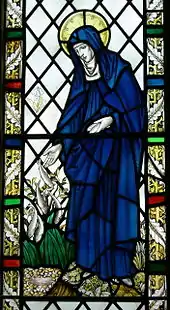
Saint Brigid of Kildare as depicted in Saint Non's chapel, St Davids, Wales
- Billy, a 7-year-old black boy captured by Creek raiders in 1788; he passed through several hands before being sold at auction in Havana, Spanish Cuba.[24]
- Billy (b. c. 1754), an enslaved man who escaped John Tayloe II's plantation and was charged with treason against Virginia during the American Revolutionary War. He was pardoned after arguing that, as a slave, he was not a citizen and thus could not commit treason against a government to which he owed no allegiance.
- Bissula (fl. 368) enslaved Alemannic woman, and muse of the Roman poet Ausonius.
- Blaesus and Blaesia, whose late Republican Rome tomb inscription names them as the freedman of Caius and the freedwoman of Aulus.[25]
- Blandina (c. 162–177), an enslaved person and Christian martyr in Roman Gaul.[26]
- Boga, a slave in Anglo-Saxon England, and all his family, were freed by his mistress Æthelgifu's will.[5]
- Maria Boguslavka (17th century), Ukrainian woman enslaved in a harem, and became a heroine of assisting the escape of 30 Cossacks from slavery.
- The Bodmin manumissions, a manuscript now in the British Library [27] preserves the names and details of slaves freed in Bodmin (the then principal town of Cornwall) during the 9th or 10th centuries.[28][29]
- Booker T. Washington (1856–1915), born into slavery, became an American educator, author and leader of the African-American community after the Civil War.
- Nathaniel Booth (1826–1901), escaped slavery in Virginia and settled in Lowell, Massachusetts. In 1851, the citizens of Lowell purchased his freedom from slave hunters.
- Saint Brigid of Kildare, a major Irish Saint. ccording to tradition, Brigid was born in the year 451 AD in Faughart,[30] just north of Dundalk[31][32] in County Louth, Ireland. Her mother was Brocca, a Christian Pict slave who had been baptized by Saint Patrick. They name her father as Dubhthach, a chieftain of Leinster.[33] Dubthach's wife forced him to sell Brigid's mother to a druid when she became pregnant. Brigid herself was born into slavery. The child Brigid was said to have performed miracles, including healing and feeding the poor.[34] Around the age of ten, she was returned as a household servant to her father, where her habit of charity led her to donate his belongings to anyone who asked. In two Lives, Dubthach was so annoyed with her that he took her in a chariot to the King of Leinster to sell her. While Dubthach was talking to the king, Brigid gave away his jewelled sword to a beggar to barter it for food to feed his family. The king recognized her holiness and convinced Dubthach to grant his daughter her freedom, after which she started her career as a well-konwn nun.[35]
- Brigitta Scherzenfeldt (1698–1733), Swedish memoirist and weaving teacher who was captured during the Great Northern War and lived as a slave in the kingdom of the Kalmyk in Central Asia.
- Bussa, born a free man in West Africa of possible Igbo descent and was captured by African slave merchants, sold to the British, and transported to Barbados (where slavery had been legal since 1661) in the late 18th century as a slave.[36]
C
- Caenis, a formerly enslaved woman and secretary of Antonia Minor (mother of the emperor Claudius) and the mistress of the Roman emperor Vespasian now.
- Pope Callixtus I (died 223), a formerly enslaved man, pope from about 218 to about 223, during the reigns of the Roman Emperors Heliogabalus and Alexander Severus. He was martyred for his Christian faith and is a canonized saint of the Roman Catholic Church.[37]
- Callistratus, an Athenian enslaved man and banker.[38]
- Carlota (died 1844), led a slave rebellion on Cuba in 1843–1844.
- Castus, a Gallic slave and one of the leaders of rebellious slaves during the Third Servile War
- Cato, an African-American enslaved man who served as an American Black Patriot spy and courier gathering intelligence with his owner, Hercules Mulligan.
- Cato (died 1803), an enslaved man in Charleston, New York, who murdered twelve-year-old Mary Akins after an attempted rape. His confession was published in the murder literature of the time.[39]
- Cesar Picton (c. 1765–1831), enslaved in Senegal, worked as a servant in England, and later became a wealthy coal merchant.
- Cezayirli Gazi Hasan Pasha (1713–1790), a Georgian enslaved man in the Ottoman Empire who rose to be grand vizier, Kapudan Pasha and an army commander.
- Cevri Kalfa, a Georgian enslaved girl at the Sultan's harem in Istanbul, who saved Mahmud II's life and was rewarded for her bravery and loyalty by being appointed haznedar usta, the chief treasurer of the imperial Harem.
- Charles Ayres Brown, mixed-raced enslaved man born in Buckingham County, Virginia around 1820 or 1821 and was a part of the contraband camp during the American Civil War in Corinth, Mississippi. He was in Company E. He was legally married to Minerva Brown in 1867 and they had six children.
- Charles Deslondes, Haitian mulatto tasked with overseeing other enslaved people on the André plantation and leader of the 1811 German Coast Uprising in present-day Louisiana. He was brutally killed by the "militia" which put down the slave revolt.
- Charles Taylor, an enslaved man freed by General Benjamin F. Butler in New Orleans, was described in a Harper's Weekly article as appearing white and having come to a school for emancipated slaves in Philadelphia.[40]
- Charlotte Aïssé, (c. 1694 – 13 March 1733), a French letter-writer, the daughter of a Circassian chief.
- Charlotte Dupuy (c. 1787–1790–c. 1866), also called Lottie, filed a freedom suit in 1829 against her master, Henry Clay, then Secretary of State, and lost.
- Chica da Silva (c. 1732–1796), also known as Xica da Silva, Brazilian courtesan who became famous for becoming rich and powerful despite having been born into slavery.
- Christopher Shields (born 1774), enslaved by George Washington and kept in slavery at Mount Vernon. The location and year in which he died is unknown.
- Claudia Prepontis, a Roman freedwoman who erected in the 1st century AD a funerary altar to her freedman husband T. Claudius Dionysius; their clasped hands, depicted on it, show the legitimacy of their marriage, possible only once they obtained their freedom.[41]
- Clara Brown (c. 1800–1885), a former Virginian enslaved woman who became a community leader, philanthropist and aided settlement of former enslaved people during Colorado's Gold Rush.
- Pope Clement I (died 100), the fourth Pope according to Catholic tradition. He may have been a freedman of Titus Flavius Clemens.[42]
- Cleon (died 132 BC) leader in the First Servile War.
- Cole, an enslaved person in Anglo-Saxon England freed by Geatflæd "for the love of God and the good of her soul".[5]
- Colonel Tye (1753–1780), also known as Titus Cornelius, a former enslaved man, became a Black Loyalist soldier and guerrilla leader during the American Revolution.
- Cooper, a black enslaved man around 20 years old, fled to the Creek. He was captured for sale to the whites and killed after he wounded a warrior.[43]
- Crixus, a Gallic gladiator and military leader in the Third Servile War.
- Cudjoe Lewis (c. 1840–1935), considered the last person born in Africa to have been enslaved in the United States.
- Cuffy (died 1763), was an Akan man who was captured in his native West Africa, taken to work in the plantations of the Dutch colony of Berbice in present-day Guyana, and in 1763 led a revolt of more than 2,500 slaves against the colonial regime. Today, he is a national hero in Guyana.[44]
D
.jpg.webp)
Dred Scott, who lost a legal suit for his freedom in the United States Supreme Court in 1857
- Danae, "the new maidservant of Capito", named in lead curse tablet from Republican Rome, which aimed to destroy Danae.[45]
- Dave Drake (c. 1801–1876), also known as Dave the Potter.
- David George, a black man who fled a cruel Virginia master and was captured by Creeks and enslaved by Chief Blue Salt.[46]
- Deborah Squash, with her husband Harvey escaped from George Washington's Mount Vernon, joined the British in New York during the American Revolutionary War, and were evacuated in 1783 as freedmen.[47]
- Denmark Vesey (c. 1767–1822), an African-American enslaved man and later a freeman who planned what would have been one of the largest slave rebellions in the United States had word of the plans not been leaked.[48]
- Dido Elizabeth Belle (1761–1804), born into slavery as the natural daughter of Maria Belle, an enslaved African woman in the West Indies, and Sir John Lindsay, a career Royal Navy officer. Lindsay took Belle with him when he returned to England in 1765, entrusting her raising to his uncle William Murray, 1st Earl of Mansfield, and his wife Elizabeth Murray, Countess of Mansfield. The Murrays educated Belle, bringing her up as a free gentlewoman at their Kenwood House, together with their niece, Lady Elizabeth Murray. Belle lived there for 30 years. In his will of 1793, Lord Mansfield confirmed her freedom and provided an outright sum and an annuity to her, making her an heiress.
- Diego was a freed slave closely associated with the Elizabethan English navigator Francis Drake. In March 1573, Drake raided Darien (in modern Panama), in which he was greatly aided by Maroons - African slaves who had escaped cruel Spanish masters and were glad to help their English enemies. One of them was Diego, who proved a capable ship builder and accompanied Drake back to England. In 1577, when Queen Elizabeth sent Drake to start an expedition against the Spanish along the Pacific coast of the Americas - which eventually developed into Drake circumnavigating the world - Diego was once again employed under Drake; his fluency in Spanish and English would make him a useful interpreter when Spaniards or Spanish-speaking Portuguese were captured. He was employed as Drake's servant and was paid wages, just like the rest of the crew. Diego died while Drake's ship was crossing the Pacific, of wounds sustained earlier in the voyage. Drake was saddened at his death, Diego having become a good friend.[49]
- Diogenes of Sinope (c. 412–323 BCE), Greek philosopher kidnapped by pirates and sold in Corinth.
- Diondre Hammond, hailed from Africa, sent by British to colonial America, later escaped to what is now southern California.
- Dincă, the half-Roma enslaved man and illegitimate child of a Cantacuzino boyar in the 19th-century Danubian Principalities (present-day Romania). Well-educated, working as a cook but not allowed to marry his French mistress and go free, which had led him to murder his lover and kill himself. The affair shocked public opinion and was one of the factors contributing to the abolition of slavery in Romania. [50]
- Diocletian (244–312), Emperor of Rome, was by some sources born as the slave of Senator Anullinus. By other sources, it was Diocletian's father (whose own name is unknown) who was a slave, and was freed prior to the birth of his son, the future emperor.[51]
- Dionysius I (? – 1492), Ecumenical Patriarch of Constantinople, previously enslaved by the Ottomans after the Fall of Constantinople in 1453.
- Dragut (1485–1565) Ottoman commander, gally slave during his Italian captivity.
- Dred Scott (c. 1799–1858), an African-American enslaved man in Missouri who attempted to sue for his freedom in a nationally publicized trial, Scott v. Sandford, that reached the United States Supreme Court in 1857.
- Dufe the Old, an enslaved man in Anglo-Saxon England, was freed by his mistress Æthelgifu's will.[52]
E

Florence, Lady Baker c. 1875. A Romanian sold as a slave as an orphan, was bought by Samuel Baker, who married her.
- Ecceard the Smith, an enslaved person in Anglo-Saxon England freed by Geatflæd "for the love of God and the good of her soul".[52]
- Ecgferð Aldun's daughter, an enslaved person in Anglo-Saxon England freed by Geatflæd "for the love of God and the good of her soul".[52]
- Edmond Flint, a black enslaved person among the Choctaw Nation who later described it as very like slavery among the whites.[53]
- Ediþ, an enslaved woman in Anglo-Saxon England who bought her freedom and that of her children.[54]
- Edward Mozingo, Sr., (c. 1649 – 1712), kidnapped from Africa when ~10 years old, sold into slavery in Jamestown, Virginia. After his master died, he sued for his freedom and won it. He married an impoverished white woman, Margaret Pierce Bayley (1645–1711) and together they, essentially, founded the Mozingo family line in North America.[55]
- Elijah Abel (1808–1884), born in Maryland as an enslaved person and believed to have escaped slavery on the Underground Railroad into Canada. He joined The Church of Jesus Christ of Latter-day Saints in its early days, was among the first blacks to receive its priesthood and the first black person to rise to the ranks of an elder and seventy.
- Edith Hern Fossett, a woman enslaved by U.S. President Thomas Jefferson, was taught to cook by a French chef and created French cuisine at the White House and at Monticello.
- Eliezer of Damascus, Abraham's slave and trusted manager of the Patriarch's household in the Hebrew Bible.
- Eliza Hopewell, an enslaved woman of Confederate spy Isabella Maria Boyd ("Belle Boyd"). In 1862 she helped her mistress' espionage activities, carrying messages to the Confederate Army in a hollowed-out watch case.
- Eliza Moore (1843 – January 21, 1948), one of the last proven African-American former slaves living in the United States.
- Elias Polk (1806 – December 30, 1886), a conservative political activist of the 19th century.
- Elizabeth Key Grinstead (1630–after 1665), the first woman of African ancestry in the North American colonies to sue for her freedom and win. Key and her infant son, John Grinstead, were freed on July 21, 1656, in the colony of Virginia, based on the fact that her father was an Englishman and that she was a baptized Christian.
- Elizabeth Freeman (c. 1742 – 1829), known as Bett and later Mum Bett, was among the first black slaves in Massachusetts to file a freedom suit and win in court under the 1780 constitution, with a ruling that slavery was illegal.
- Elizabeth Hobbs Keckley (1818–1907), best known as the personal modiste and confidante of Mary Todd Lincoln, the First Lady of the United States. Keckley wrote and published an autobiography, Behind the Scenes: Or, Thirty Years a Slave and Four Years in the White House (1868).
- Ellen Craft (1826–1891), light-skinned wife of William Craft, who escaped with him from Georgia to Philadelphia, by posing as a white woman and her slave, in a case that became famous.
- Ellen More, an enslaved woman brought to the royal Scottish court
- Elsey Thompson, a white captive enslaved by a Creek. When trader John O'Reilly attempted to ransom her and Nancy Caffrey, he was told they were not taken captive to be allowed to go back, but to work.[56]
- Emilia Soares de Patrocinio (1805–1886) was a Brazilian slave, slave owner and businesswoman.
- Emiline (age 23); Nancy (20); Lewis, brother of Nancy (16); Edward, brother of Emiline (13); Lewis and Edward, sons of Nancy (7); Ann, daughter of Nancy (5); and Amanda, daughter of Emiline (2), were freed in the 1852 Lemmon v. New York court case after they were brought to New York by their Virginia slave owners.
- Emily Edmonson (1835–1895), along with her sister Mary, joined an unsuccessful 1848 escape attempt known as the Pearl incident, but Henry Ward Beecher and his church raised the funds to free them.
- Enrique of Malacca, also known as Henry the Black, slave and interpreter of Ferdinand Magellan and possibly the first man to circumnavigate the globe in Magellan's voyage of 1519–1521.
- Epictetus (55 – c. 135), ancient Greek stoic philosopher.
- Epunuel, a native of Chappaquiddick who was taken captive by English explorers in the 1610s with twenty-nine others, and taken to London as a slave.[57]
- Estevanico (1500–1539), also known as Esteban the Moor. In principle he was a slave of the Portuguese to, later, be a servant of the Spaniards. He was one of only four survivors of the ill-fated Narváez expedition, later a guide in search of the fabled Seven Cities of Gold and possibly the first African person to arrive in what is now Arizona and New Mexico.
- Eucharis, a Greek born freedwoman of Roman Licinia, described in her epitaph in the 1st century AD as fourteen when she died, a child actress and a professional dancer.[58]
- Eunus (died 132 BC), a Roman enslaved person from Apamea in Syria, the leader of the slave uprising in the First Servile War
- Euphraios, an Athenian enslaved person and banker.[38]
- Exuperius and Zoe (died 127), 2nd-century Christian martyrs. They were a married couple who were enslaved by a pagan in Pamphylia. They were killed along with their sons, Cyriacus and Theodolus, for refusing to participate in pagan rites when their son was born.[59]
F
.jpg.webp)
Frederick Douglass, the foremost African-American abolitionist of the 19th century
.JPG.webp)
Self-portrait by Fyodor Slavyansky (1850s, Russian museum)
- Fabia Arete, Ancient Roman actress and freedwoman who is referred to as an elite actress or archimima who enjoyed a highly successful career and likely belonged to the minority of female actors to perform speaking parts.[60]
- Felicitas (died 203), Christian martyr and saint.[61]
- Fiddih, acquired by the Báb when she was no older than 7 years of age, Fiddih served the Báb's wife Khadíjih-Bagum.[62] Fiddih would die the same night as her master.[63]
- Fountain Hughes (1848—1957), interviewed in June 1949 about his life by the Library of Congress as part of the Federal Writers' Project.
- Francis Bok (born 1979), Dinka slave from South Sudan, now an abolitionist and author in the United States.
- Francisco Menendez, an enslaved man from South Carolina who escaped to Spanish Florida, where he served in the Spanish militia, leading the garrison established in 1738 at Fort Mose. This site was the first legal free black community in what is now the United States.
- François Mackandal (died 1758), Haitian Maroon leader.
- Frederick Douglass (1818–1895), born into slavery in Maryland and escaped to the Northeast in 1838, where he became an internationally renowned abolitionist writer, speaker, and diplomat.
- French John, a French fur trader captured by the Cherokee and enslaved by Old Hop, apparently making no effort for his freedom for many years, until he ran away when the British offered to buy him.[64]
- C. Furius Cresimus, ancient Roman. As a freedman, he produced such crops from his small farm that he was accuse of witching away other people's crops, but when he produced his agricultural implements in court, he was acquitted. Pliny the Elder recounts his tale as evidence that hard work is what counts in farming.[65]
- Fyodor Slavyansky (1817–1876), Russian serf painter.
G
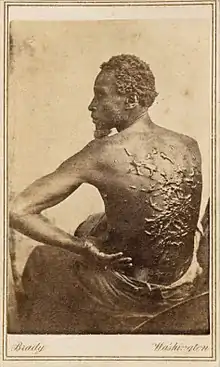
Medical examination photo of Gordon showing his scourged back, widely distributed by abolitionists to expose the brutality of slavery
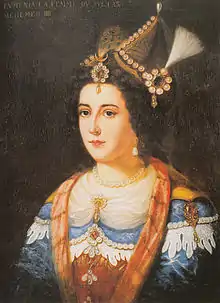
Portrait of Gülnuş Sultan
- Gabriel Prosser (1776–1800), leader of Virginia slave revolt.
- Galeria Lysistrate (2nd-century), mistress of the Roman Emperor Antoninus Pius.
- Ganga Zumba or Ganazumba (c. 1630 – 1678), a descendant of an unknown king of Kongo who escaped slavery in colonial Brazil and became the first leader of the runaway slave settlement of Quilombo dos Palmares.
- Gannicus, a Celtic enslaved person and one of the leaders of rebel slaves during the Third Servile War
- Genghis Khan (c. 1162 – August 18, 1227), captured after a raid and enslaved by the Taichiud.
- George Africanus (1763–1834), an African slave from Sierra Leone who became a successful entrepreneur in Nottingham.
- George Edward Doney (1758–1809), Gambian man enslaved by William Capell, 4th Earl of Essex.
- George Freeman Bragg (1863–1940), born into slavery in North Carolina and later became a leading Episcopal priest and social activist.
- George Lewis (1794–1811), also known as Slave George, was a slave murdered in Kentucky on the night of December 15–16, 1811.
- George Moses Horton (1797–1884), the first African-American poet to be published in the Southern United States.
- George Sanders, a black enslaved person among the Cherokee, who described his oppressors as kind and providing clothes and food.[53]
- George Washington Carver (c. 1864 – 1943), an African-American scientist, botanist, educator and inventor known for encouraging cultivation of alternative crops to cotton such as sweet potatoes and peanuts in the South; born into slavery in Missouri and freed as a young child following the American Civil War.
- Giles, father of George Washington Carver.
- Glaumur, enslaved by the outlaw Grettir in early medieval Iceland (protagonist of "Grettis saga"). Glaumur is mentioned as loyally sharing his master's long exile on the lonely island of Drangey, off the northern tip of Iceland, though in the circumstances described in the saga he could have easily escaped.
- Gosala, a sixth-century BC ascetic teacher of ancient India – a contemporary (and rival) of Gautama Buddha – was said to have been born into slavery, and became a naked ascetic after fleeing from his irate captor, who managed to grab hold of Gosala's garment and disrobe him as he fled.
- Gonzalo Guerrero (died 1536), a sailor from Palos, Spain, who shipwrecked along the Yucatán Peninsula in 1511 and was enslaved by the local Maya.
- Gordon, also known as Whipped Peter, an African-American enslaved man who escaped to a Union Army camp from a plantation near Baton Rouge, Louisiana in 1863. The images of Gordon's scourged back taken during a medical examination were published in Harper's Weekly and provided Northerners visual evidence of the brutality of slavery. They inspired many free blacks to enlist in the Union Army.[66]
- Gryphus Ancient Roman enslaved person. The epigraph of the slave boy Iucundus describes him as the son of Gryphus and Vitalis.[67]
- Gülnuş Sultan (1642 – 6 November 1715) was Haseki Sultan of Ottoman Sultan Mehmed IV and Valide Sultan to their sons Mustafa II and Ahmed III.
- Guðríður Símonardóttir (1598–1682), Icelandic woman taken captive by North African slavers (Barbary Pirates).
- Gustav Badin (died 1822), butler at the royal Swedish court.
H
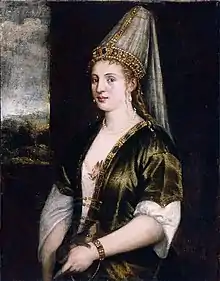
Hurrem Sultan, an Eastern European slave girl bought by the Ottoman Sultan Süleyman the Magnificent, who married her.
- Hababah, beloved concubine of Caliph Yazid II.
- Hagar, biblical figure, belonging to Sarah.
- Hanna, an enslaved woman in Virginia, and grandmother of Jackey Wright, who sued for her freedom in Hudgins v. Wright (1806) on the grounds that three generations descended from Butterwood Nan, who was an American Indian, not a black. The Virginia Supreme Court affirmed a lower court decision by George Wythe, that because of Jackey's and Hanna's appearance as mixed Indian and European, she was entitled to the presumption of freedom, given the limited nature of Indian slavery. St. George Tucker and Spencer Roane said that, as most Africans had been imported as slaves and blacks descended from slave mothers, a black would not have the same presumption of freedom.[68][69]
- Hannah Bond (born 1830s), pen name Hannah Crafts,[70] wrote The Bondwoman's Narrative after gaining her freedom. Possibly the first novel by an African-American woman, it is the only known novel by a fugitive slave woman.
- Hark Olufs (1708–1754), Danish sailor, was captured by Algerian pirates. Sold to the Bey of Constantine, he became Commander in Chief of the Bey's cavalry. He was released in 1735.
- Harriet Jacobs (1813–1897), author of Incidents in the Life of a Slave Girl.
- Hark Olufs (1708–1754), a North Frisian sailor, captured by Algerian pirates and sold into slavery.
- Harriet Powers (1837–1910), American folk artist, and quilter.
- Harriet Tubman (c. 1822 – 1913), nicknamed "Moses" because of her efforts in helping other American enslaved people escape through the Underground Railroad.
- Harry, the plaintiff in the 1818 Harry v. Decker & Hopkins decision by the Supreme Court of Mississippi (the first among U.S. southern states) to free an enslaved person solely on the basis of prior residence in a free territory.
- Harry Washington (died 1800), also known as Henry Washington, was a slave of George Washington.[71] Transported as a slave to America, he was bought by Washington in 1763 to work on a project for draining the Great Dismal Swamp.[72]
- Hafsa Sultan (died March 1534) was the wife of Selim I and the first valide sultan of the Ottoman Empire as the mother of Suleiman the Magnificent. Her background is disputed but some historians hold that she was a slave.
- Helen Gloag (1750–1790), of Muthill, Perthshire, Scotland, became the Empress of Morocco as the harem slave of the sultan of Morocco.[73]
- Hercules (born c. 1755), head cook enslaved by George Washington at Washington's plantation, Mount Vernon. He escaped and gained his freedom in 1797, but his wife Alice and his three children remained in slavery.
- Helvius Successus, freed slave, and father of the Roman emperor Pertinax.
- Hermas, author of the text The Shepherd of Hermas and brother of Pope Pius I.
- Hernando de Escalante Fontaneda, born in Cartagena, was enslaved at the age of 13 when the ship bearing him to Spain for education sank off Florida. A Calusa chief enslaved him and used him as a translator until he was ransomed at 30.[74]
- Horace (65 BC–8 BC), Roman poet.
- Horace King (architect) (1807–1885), American architect, engineer, and bridge builder, was born into slavery on a South Carolina plantation.
- Hümaşah Sultan (fl. 1647 – fl. 1672) was the wife of Sultan Ibrahim of the Ottoman Empire.
- Hurrem Sultan (c. 1502 – 15 April 1558), also known as Roxelana, an Eastern European girl, was captured by slave raders and sold to the Imperial Harem, becoming the chief consort and legal wife of the Ottoman Sultan Süleyman the Magnificent.
I
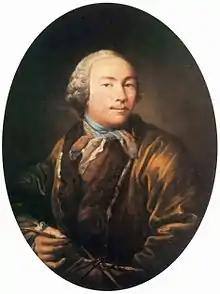
Ivan Argunov. Self-portrait (late 1750s).
- İbrahim Pasha (c. 1495 – 1536), Suleiman the Magnificent's first appointed Grand Vizier. Greek by birth, he was sold as a slave at the age of six to the Ottoman palace for future sultans; there he befriended Suleiman, who was of the same age.
- Icelus Marcianus, an enslaved person and later freedman of the Roman emperor Galba in the 1st century CE. He was one of three men said to completely control the emperor, increasing Galba's unpopularity.
- Ida B. Wells (1862–1931), prominent African-American activist, born a slave, who in later life campaigned against and succeeded in abolishing lynching. She co-founded the National Association for the Advancement of Colored People (NAACP) in 1909.
- Imma, a Northumbrian aristocrat who was knocked unconscious in battle and later pretended to have been a peasant who brought them food, so that his captors did not kill him. His manners and bearing soon betrayed him, and he was sold into slavery.[75]
- Isabel de Solís (fl. 1485) the Castilian slave concubine of Abu l-Hasan Ali, Sultan of Granada.[76]
- Isabella Gibbons (1826–1890), became a schoolteacher in Virginia after liberation in 1865.
- Isfandíyár, a servant in Bahá'u'lláh's house in Tehran,[77] Isfandíyár died in Mazandaran[78][79]
- Israel Jefferson (c. 1800 – after 1873), known as Israel Gillette before 1844, was born a slave at Monticello, the estate of Thomas Jefferson, and worked as a domestic servant close to Jefferson for years.
- Isthmias, a woman in ancient Greece described in Against Neaera as the property of Nicarete, who prostituted her.
- Iucundus, Ancient Roman slaveboy, described in his epitaph as the slave of Livia, the wife of Drusus Caesar, the son of Gryphus and Vitalis. It states he was seized and murdered by a witch, and warns parents to guard their children to prevent such a fate.[67]
- Ivan Bolotnikov (1565–1608), a fugitive kholop (slave in Russia) and leader of the Bolotnikov rebellion in 1606–1607.
- Ivan Argunov (1729–1802), Russian serf painter, one of the founders of the Russian school of portrait painting.
J
- Jack Gladstone, leader of the Demerara rebellion of 1823.
- Jackey Wright, an American enslaved woman who sued for and won her freedom in the famous 1806 Virginia case of Hudgins v. Wright. However, the opinion of the Virginia Supreme Court relied on Wright appearing white and Native American, whereas the lower court under George Wythe had tried to establish a presumption of freedom for all people, of whatever race.
- James Armistead Lafayette (1760–1830), an African-American enslaved man who served the Continental Army in the American Revolutionary War as a double agent.
- James Baugh, an enslaved American who sued for his freedom on the grounds that his maternal grandmother had been an Indian.[80]
- James Hemings (1765–1801), American mixed-race man enslaved and later freed by Thomas Jefferson. He was the older brother of Sally Hemings and a half-sibling of Jefferson's wife, Martha Wayles Skelton Jefferson, through their father John Wayles.
- James Leander Cathcart (1767–1843), a diplomat, slave, and sailor notable for his narrative as a slave in Algiers for eleven years and for his diplomatic accomplishments while in slavery.
- James M. Priest (1819–1883), 6th Vice President of Liberia, born into slavery in Kentucky
- James Somersett or Somerset, an enslaved man in colonial America whose escape while in England in 1771, supported by notable British abolitionists, led to the milestone legal case Somerset v Stewart, which effectively ended slavery in Britain, though not in its colonies.
- Jane Johnson (1814 or 1827–1872), gained freedom on July 18, 1855, with her two young sons while in Philadelphia with her master and his family. She was aided by William Still and Passmore Williamson, abolitionists of the Pennsylvania Anti-Slavery Society and its Vigilance Committee.
- Jean Amilcar (c. 1781–1793), the Senegalese foster son of Marie Antoinette.
- Jean-Jacques Dessalines (1758–1806), leader of the Haitian Revolution and first leader of independent Haiti.
- Jean Marteilhe (1684–1777), French Huguenot slave narrator, served as a galley slave.
- Jean Saint Malo (died 1784), leader of runaway enslaved people (maroon colony) in Spanish Louisiana and namesake of Saint Malo, Louisiana.
- Jean Parisot de Valette (1495–1568), a knight of the Order of Saint John was captured and made a galley slave in 1541 by Barbary pirates under the command of Turgut Reis. He was freed after about a year and later became Grandmaster of the Order.
- Jeffrey Hudson (1619 – c. 1682), an English courtier who spent 25 years as a slave in North Africa.
- Jehu Grant (c. 1752–December 28, 1840), Revolutionary War veteran.
- Jerry – see William Henry
- Jim Cuff or Jim Crow was a crippled African enslaved man, variously claimed to have resided in St. Louis, Cincinnati, or Pittsburgh,[81][82] whose song and dance supposedly inspired the blackface song and dance "Jump Jim Crow" by white comedian Thomas D. Rice. The great popularity of Rice's creation soon led to Jim Crow becoming a pejorative name for blacks, and later to the name being used for the segregationist Jim Crow Laws, a highly unfair posthumous memory of the original crippled slave.
- Joana da Gama (c. 1520–1586), a Portuguese maid-of-honor and writer.
- Joe was a slave belonging to William B. Travis, one of the Texian commanders in the Battle of Alamo. After the Texian defeat, the Mexican General Santa Anna spared Joe, hoping to convince other slaves in Texas to support the Mexican government over the Texian rebellion.[83] Afterwards, Joe together with some other survivors were sent to Gonzales and encouraged to relate the events of the battle, and to inform the remainder of the Texian forces that Santa Anna's army was unbeatable.
- John Axouch (1087–1150), a Seljuk Turk captured as a child by the Byzantine Empire, freed and raised in the imperial household as the companion of the future Emperor John II Komnenos, and on his accession given command of the Empire's armies and remaining the Emperor's only close personal friend and confidant.
- John "Lit" Fleming, born into slavery in Virginia but later moved to Edmundson, Arkansas, with his parents and siblings. He would then move to Memphis, Tennessee, and was part-owner of the newspaper Memphis Free Speech with activist Ida B. Wells-Barnett.
- John Munroe Brazealle and his mother were the subjects of Hinds v. Brazealle (1838), a case in the Supreme Court of Mississippi which denied the legality and inheritance rights in Mississippi of deeds of manumission executed by Elisha Brazealle, a Mississippi resident, in Ohio to free the pair.
- John Brown (c. 1810–1876), escaped and wrote of conditions in the Deep South of the United States.
- John Casor, the first to be enslaved as the result of a civil case in the Thirteen Colonies (Virginia Colony, 1655).
- John Ezzidio (c. 1810–1872), Nigerian enslaved man who became a successful Sierra Leonese politician and businessman.
- John Jea (born 1773), African-American enslaved man best known for his 1811 autobiography, The Life, History, and Unparalleled Sufferings of John Jea, the African Preacher.
- John Joyce born into slavery in Maryland, served in the United States Navy, held a variety of jobs after, and murdered a shopkeeper, Sarah Cross; his life and crime recounted in the murder literature of his day.[84]
- John R. Jewitt (1783–1821), an English armourer who spent three years as a captive of Maquinna of the Nuu-chah-nulth (Nootka) people on the Pacific coast of what is now Canada.
- John Punch (fl. 1630s, living 1640), an African enslaved man in the Virginia Colony in the 17th century.[85][86] In July 1640, the Virginia Governor's Council sentenced him to serve for the remainder of his life as punishment for running away to Maryland. Many historians consider Punch the "first official slave in the English colonies,"[87] and his case as the "first legal sanctioning of lifelong slavery in the Chesapeake."[85] Historians also consider this to be one of the first legal distinctions between Europeans and Africans made in the colony,[88] and a key milestone in the development of the institution of slavery in the United States.[89]
- John S. Jacobs (1815–1873), born into slavery in North Carolina, escaped, became an abolitionist speaker and author of a slave memoir. Brother of famed author Harriet Jacobs.
- John Smith (1580–1631), English soldier, sailor, and author best known for his role in the survival of the Jamestown colony in Virginia. Smith was captured by the Crimean Tatars in 1602 while fighting in Wallachia and enslaved by the Ottoman Empire, but escaped and returned to England by 1604. As Smith described it: "we all sold for slaves, like beasts in a market-place."[90]
- William Jones was an enslaved man who was acquired by Ulysses S. Grant from his father-in-law. Jones was thirty-five-year-old at the time the same year.[91] Although Grant was not an abolitionist, he was not considered a "slavery man", and could not bring himself to force a slave to do work.[92] In March 1859, Grant freed William by a manumission deed, potentially worth at least $1,000, when Grant needed the money.[93] The case of William Jones got much attention from later historians, and used in debates on Grant's attitude to slavery.
- Jordan Anderson (1825–1907), best known for a letter sent to his former oppressor/master in response to the latter's request that Jordan return to his service.
- Jordan Winston Early (1814 – after 1894) was an American Methodist multiracial preacher who was the subject of a book about his life as a slave.
- John White, an enslaved black boy who was captured by Creeks in 1797 and escaped back to New Orleans, where he told Spanish officials of his master's name, to be returned.[94]
- José Antonio Aponte leader of the Aponte conspiracy.
- Joseph, important figure in the Old Testament and the Quran.
- Joseph Antonio Emidy (1775–1835), violinist and composer born in Africa, died in Cornwall.
- Joseph Cinqué (1814–1879), also known as Sengbe Pieh, leader of a slave rebellion on the slave ship La Amistad and defendant in the subsequent Supreme Court case United States v. Amistad in 1839.
- Joseph Jackson Fuller (1825–1908), one of the earliest enslaved people to be freed in Jamaica, initially under the partial freedoms of the 1833 Slavery Abolition Act.
- Joseph Knight, successfully sought his freedom through a legal suit in Scotland in 1777, a case which established that Scots law would not uphold the institution of slavery.
- Josephine Bakhita (c. 1869–1947), Sudanese-born Roman Catholic Canossian nun and saint.
- Joshua Glover, fugitive enslaved man saved by abolitionists at Racine, Wisconsin in 1854.
- Juan Francisco Manzano (c. 1797–1854), Cuban poet.[95]
- Juan Gros, a free black soldier captured near Pensacola by an Upper Creek, who sold him to a white trader who sold him to the Mitasuki chief Kinache, from whom Spaniards ransomed him.[96]
- Juan Latino, called "el negro Juan Latino", from Ethiopia, brought to Spain as a child, received an education and rose to be professor of Latin at the University of Granada, in 16th-century Spain.
- Juan Ortiz, a young Andalusian nobleman enslaved by Chief Ucita in Florida to avenge injuries he suffered at the hands of the expedition Ortiz belonged to.[97]
- Julia Chinn, an octoroon enslaved woman and common-law wife of Richard Mentor Johnson, ninth Vice President of the United States.
- Julia Frances Lewis, mother of Amanda American Dickson by the son of her owner.[98]
- Jupiter Hammon (1711–before 1806), in 1761 became the first African-American writer to be published in the present-day United States. Born into slavery, Hammon was never emancipated. He is considered one of the founders of African-American literature.
K
_(cropped).jpg.webp)
Kösem Sultan (1589–1651), slave concubine like all other inmates of the Imperial Harem
- Anna Kingsley (1793–1870), enslaved woman and then a planter and slave owner herself.
- Kösem Sultan (1589–1651), an Ottoman enslaved woman, later extremely powerful as wife, then mother and later grandmother of the Ottoman sultan during the 130-year period known as the Sultanate of Women.
- John Knox (c. 1514 – 24 November 1572) was a Scottish minister, galley slave in the French galleys, 1547–1549.
- Kunta Kinte (c. 1750 – c. 1822), a character from the 1976 novel Roots: The Saga of an American Family whom author Alex Haley claimed was based on one of his actual ancestors. Kinte was supposedly a man of the Mandinka people who grew up in a small village called Juffure in what is now The Gambia and was raised as a Muslim before being captured and enslaved in Virginia.[99] The historical accuracy of Haley's story is disputed.[100]
- Kizzy Kinte, the supposed daughter of Kunta Kinte.[101] As with her father, the existence of an historical Kizzy Kinte is disputed.
- King Jaja of Opobo (1821–1891), sold at about the age of 12 into slavery in the Kingdom of Bonny in present-day Nigeria. Proving at an early age his aptitude for business, he not only earned his way out of slavery but also became a rich and powerful merchant prince and the founder of the Opobo city-state, his career eventually ended by the British colonizers whom he tried to defy.
L
- Lamhatty, a Tawasa Indian captured and enslaved by Creek; he escaped.[102]
- Laurens de Graaf (c. 1653–1704), a Dutch pirate, mercenary, and naval officer, enslaved by Spanish slave traders when captured in what is now the Netherlands and transported to the Canary Islands to work on a plantation, prior to 1674.
- La Mulâtresse Solitude (1772–1802), a slave on the island of Guadeloupe freed in 1794 by the abolition of slavery during the French Revolution. She was executed after having fought for freedom when slavery was reintroduced by Napoleon in 1802.
- Leo Africanus, (1494–1554), a Moor born in Granada who was taken by his family in 1498 to Morocco when expelled from Spain. As an adult he served on diplomatic missions. Captured by Crusaders while in the Middle East, he was enslaved in Rome and forced to convert to Christianity. He eventually regained his freedom and lived out his life in Tunis.
- Leofgifu the dairy maid, an enslaved woman in Anglo-Saxon England, named in her manumission.[103]
- Leoflaed, an enslaved woman in Anglo-Saxon England, whose freedom was bought by a man who described her as a "kinswoman."[104]
- Leonor de Mendoza, an enslaved woman in colonial Mexico who tried to marry Tomás Ortega, an enslaved man of another master; when her master imprisoned Tomás, she appealed to a church court for assistance, and it threatened excommunication for the master if he did not free Tomás.[105]
- Lewis Adams (1842–1905), a former slave who co-founded the Tuskegee Institute, now Tuskegee University, in Alabama.
- Lilliam Williams, a Tennessee settler who was captured by the Creek while pregnant. The Creek adopted her daughter (whom she named Molly and they named Esnahatchee,); they kept the girl when Williams' freedom was arranged.[106]
- Liol, a Chinese enslaved man of the Mongol banner man Soosar. He was rewarded with semi-independent status, as a separate register dependent. In 1735, his son Fuji tried to claim that he and his brother were in fact Manchus and detached household bannermen, but failed.[107]
- Jermain Wesley Loguen (1813–1872), an African-American escaped enslaved man who became an abolitionist, a bishop of the African Methodist Episcopal Zion Church, and the author of a slave narrative.
- Louis Hughes (1832–1913), African-American escaped enslaved man, author, and businessman[108]
- Lovisa von Burghausen (1698–1733), Swedish writer who published an account of being enslaved in Russia after being taken prisoner during the Great Northern War.
- Lucius Agermus, freedman of Agrippina the Elder.[109]
- Lucius Aurelius Hermia, a freedman butcher whose tombstone glorifies his marriage with his fellow freedwoman Aurelia Philematium.[110]
- Lucius Cancrius Primigenius, a freedman of Clemens in an inscription praising him for breaking spells against the city.[111]
- Lucius of Campione, who lost a lawsuit in the 8th century over a man Toto's claimed ownership of him.[112]
- Lucy, the black woman enslaved by John Lang. She was taken captive by the Creek when 12 years old and kept in slavery in Creek territory, where she had slave children and grandchildren.[113]
- Lucy Ann (Berry) Delaney (1830–1891), former enslaved woman and daughter of Polly Berry.
- Lunsford Lane (1803 – after 1870), an African-American enslaved man and entrepreneur from North Carolina who bought freedom for himself and his family. He also wrote a slave narrative.
- Lyde, an enslaved woman freed by the Empress Livia.[114]
- Lydia, an enslaved woman who was shot and wounded by her captor when she struggled to escape a whipping. The action was ruled legal by the Supreme Court of North Carolina in 1830 (see North Carolina v. Mann).
- Lydia Carter, the "Little Osage Captive," captured and enslaved among the Cherokee. She was ransomed by Lydia Carter, who made her her namesake. The Osage attempted to reclaim her, but she took ill and died.[115]
- Lydia Polite, mother of Robert Smalls.
M
- JaVayla Gayden, leader of a slave revolt on board the slave ship Creole in 1841.
- Malchus, slave of Caiaphas.
- Malik Ambar, born in 1548 as Chapu, a birth-name in Harar, Adal Sultanate in Somalia. He was from the now extinct Maya ethnic group. As a child he was sold in slavery by his parents[116] Mir Qasim Al Baghdadi, one of his slave owners, eventually converted Chapu to Islam and gave him the name Ambar, after recognizing his superior intellectual qualities.[117][118] Malik was brought to India as a slave. While in India he created a mercenary force numbering up to 1500 men. It was based in the Deccan region and was hired by local kings. Malik became a popular Prime Minister of the Ahmadnagar Sultanate, showing administrative acumen. He is also regarded as a pioneer in guerilla warfare in the region. He is credited with carrying out a revenue settlement of much of the Deccan, which formed the basis for subsequent settlements. He is a figure of veneration to the Siddis of Gujarat. He humbled the might of the Mughals and Adil Shah of Bijapur and raised the low status of the Nizam Shah.[119][120]
- La Malinche (c. 1496 or c. 1501 – c. 1529), a Nahua woman given as a slave to Spanish conquistador Hernán Cortés. She became his personal interpreter, advisor, and mistress during the Spanish conquest of Mexico.
- Mammy Lou (1804 – after 1918), a former enslaved woman who lived to extreme old age and became an actress in the 1918 silent film The Glorious Adventure.
- Manes, a man enslaved by Diogenes of Sinope. He ran away shortly after his master arrived in Athens, and Diogenes failed to pursue him on the grounds that if Manes could live without him, it would be disgraceful if he could not equally live without Manes.
- Manjeok, Korean enslaved person, leader of an abortive slave uprising.
- Mann, the name of two enslaved people in Anglo-Saxon England, one a goldsmith, who were both freed by their mistress Æthelgifu's will. The wife of the Mann not a goldsmith was also freed.[52]
- Manjutakin (died 1007), a Turkish-born military enslaved person (ghulam) and general of the Fatimids.
- Marcos Xiorro, a Puerto Rican enslaved man who, in 1821, planned and conspired to lead a slave revolt against the sugar plantation owners and the Spanish colonial government in Puerto Rico. Though the conspiracy was unsuccessful, Xiorro achieved legendary status among the slaves and is part of Puerto Rico's folklore.[121]
- Marcia, mistress of the Roman Emperor Commodus.
- Marcius Agrippa (late 2nd and early 3rd century), an enslaved man who was not only freed but eventually elevated to senatorial rank by the Roman emperor Macrinus.
- Marcus Tullius Tiro (c. 103 – 4 BCE), Roman author, enslaved man, and secretary of the Roman politician Cicero, later freed. He invented a long-lasting system of shorthand and wrote books that are now lost.
- Margaret Garner (1835–1858), an enslaved woman in antebellum America infamous for killing her own daughter rather than see the child returned to slavery.
- Margaret Himfi (before 1380 – after 1408), a Hungarian noblewoman who was abducted and enslaved by Ottoman marauders in the late 14th century. She later became an enslaved mistress of a wealthy Venetian citizen of Crete, with whom she had two daughters. Margaret returned to Hungary in 1405.
- Maria ter Meetelen (1704 – fl. 1751), Dutch writer of a slave narrative, enslaved by pirates and sold to the sultan of Morocco. Her biography is considered to be a valuable witness statement of the life of a former enslaved person (1748).
- Margaret Morgan, involved in the Prigg v. Pennsylvania United States Supreme Court case in which the court held that the federal Fugitive Slave Act precluded a Pennsylvania state law that prohibited blacks from being taken out of Pennsylvania into slavery, and overturned the conviction of Edward Prigg as a result.
- Marguerite Scypion (c. 1770s – after 1836), an African-Natchez woman born into slavery in St. Louis who sued for and eventually won her freedom.
- Maria al-Qibtiyya (died 637), also known as "Maria the Copt" (Arabic: مارية القبطية) or, alternatively, Maria Qupthiya, a Coptic enslaved person who was sent as a gift from Muqawqis, a Byzantine official, to the Islamic prophet Muhammad in 628, and became Muhammad's wife. She was the mother of Muhammad's son Ibrahim, who died in infancy. Her sister, Sirin, was also sent to Muhammad. Muhammad gave her to his follower Hassan ibn Thabit. Maria never remarried after Muhammad's death in 632, and died five years later.
- Maria, (died 1716), the leader of a slave rebellion on Curaçao.
- Maria Perkins, an enslaved woman from Virginia who wrote a letter to her husband in 1852 about their son being sold away.[122]
- Mariah Bell Winder McGavock Otey Reddick (died 1922), as an enslaved girl was given as a wedding gift in 1848 to Carrie Winder when she married John McGavock in Terrebonne Parish, Louisiana. Mariah, born in Mississippi, was taken to Franklin, Tennessee, where she lived for most of the remainder of her life. She was matched with Harvey Otey after his first wife Phebe died. They had several children, including two sets of twins, born into slavery. During the Civil War, she was sent to Montgomery to be far from Union lines and possible freedom. She has been featured in three novels: Widow of the South and Orphan Mother both by Robert Hicks and in a book by her great-grandson William 'Damani' Keene and his wife Carole 'Ife' Keene entitled CLANDESTINE: The Times and Secret Life of Mariah Otey Reddick.[123]
- Marie-Cessette Dumas, a woman enslaved by Marquis Antoine de la Pailleterie, mother of General Thomas-Alexandre Dumas, and grandmother of famous author Alexandre Dumas, père.
- Marie-Josèphe dite Angélique (died 1734), a black Portuguese enslaved woman who was tried and convicted, beaten and hanged for setting fire to her female owner's home, burning much of what is now referred to as Old Montreal.
- Marie Thérèse Metoyer, a planter, and businesswoman at the colonial Louisiana outpost of Natchitoches after being freed.
- Mark, Massachusetts man enslaved by Captain John Codman.[124] Mark's body was displayed in chains publicly near Charlestown, Massachusetts for twenty years. The gruesome display of his body was so well known at the time, the site where Mark's body was displayed is mentioned by Paul Revere as a landmark, in his 1798 account of Revere's 1775 midnight ride.[125]
- Mary, mother of George Washington Carver.
- Mary Black, one of three enslaved women charged with witchcraft during the Salem witch trials of 1692.
- Mary Calhoun, white woman and cousin of John C. Calhoun who was kidnapped by Cherokee. She never returned home.[1]
- Mary Edmonson (1832–1853), along with her sister Emily, joined an unsuccessful 1848 escape attempt known as the Pearl incident, but Henry Ward Beecher and his church raised the funds to free them.
- Mary Eliza Smith, described in various records as "slave" or "former slave," common-law wife of Michael Morris Healy and mother of his children, including James Augustine Healy, Patrick Francis Healy, Michael A. Healy, and Eliza Healy.
- Mary Fields (c. 1832–1914): the first African-American female star route mail carrier in the United States.
- Mary Mildred Williams, Nee Botts (born 1847), the original 'Poster Child' whose image was used to advance the abolitionist cause by propagandising 'White Slavery' in 1855.
- Mary Prince (c. 1788 – after 1833), the account of her life galvanized the anti-slavery movement in England.
- The Master of Morton and the eldest son of the Chief of Clan Oliphant, two Scottish nobles who were exiled from Scotland after being implicated in the 1582 Raid of Ruthven. The ship in which they sailed was lost at sea, and it was rumoured that they had been caught by a Dutch ship. The last report was that they were slaves on a Turkish ship in the Mediterranean. A plaque to their memory was raised in the church in Algiers.
- Masúd, initially purchased as a youth by Khál-i Akbar, an uncle of the Báb, Masúd would serve Bahá'u'lláh in Acre.[126]
- Mende Nazer (born c. 1982), a Nuba woman captured in Darfur and transported from Sudan to London, where she eventually won refugee status and wrote the memoir Slave: My True Story (2002).
- Menecrates of Tralles a Greek physician during the 1st century BC.
- Hans Mergest, a participant in the Crusade of Varna who was captured by the Ottomans in the Battle of Varna (1444) and spent 16 years in captivity. He was the protagonist of a song by the minnesinger Michael Beheim.
- Metaneira, a woman in ancient Greece described in Against Neaera as the property of Nicarete, who prostituted her.
- Shadrach Minkins (1814–1875), a fugitive enslaved person saved by abolitionists at Boston in 1850.
- Michael Shiner (1805–1880), enslaved laborer, painter entrepreneur, civic leader and diarist at the Washington Navy Yard.
- Miguel Perez was the Spanish name of a boy of the Yojuane people who was among 149 Yojuane women and children taken captive in 1759, during an attack on their camp by an expedition of Spaniards and Apaches along the Red River in what is now northern Texas.[127] Many of the captives died of smallpox while those who survived were made into slaves.[128] The boy was sold to a Spanish soldier who bestowed the Spanish name on him. Perez became a Hispanicized Indian of San Antonio but he continued to maintain contact with the Yojuanes. In 1786, Perez was recruited to convince the Yojuanes and their Tonkawa allies to go to war with the Lipan Apache, which he did successfully.[127]
- Mikhail Matinsky (1750–1820), Russian serf scientist, dramatist, librettist and opera composer.
- Mikhail Shchepkin (1788–1863), Russian serf actor.
- Mikhail Shibanov, Russian serf painter active during the 1780s.
- Mikhail Tikhanov (1789–1862), Russian serf artist.
- Mina Kolokolnikov (1708?–1775?), Russian serf painter and teacher.
- Mingo, the 15–16 years old enslaved boy of the Titsworth family in Tennessee, who was captured in 1794 by Creeks in a raid on the house and kept as a slave by them.[129][130]
- Minerva (Anderson) Breedlove, mother of Madam C.J. Walker.
- Hájí Mubárak, purchased at the age of 5 years old by Hájí Mírzá Abú'l-Qásím, the great-grandfather of Shoghi Effendi and brother-in-law of the Báb, Hájí Mubárak was sold to the Báb in 1842 at the age of 19 for fourteen tomans.[131] Hájí Mubárak died at about the age of 40 and is buried in the grounds of the Imam Husayn Shrine in Karbala, Iraq.
- Mustapha Khaznadar (1817–1878), born Georgios Kalkias Stravelakis, a Christian Greek on the island of Chios, captured by Ottoman troops during the 1822 Massacre of Chios, converted to Islam and given the name Mustapha, sold in Constantinople to an envoy of the Husainid Dynasty. He was raised by the family of Mustapha Bey, then by his son Ahmad I Bey[132] while he was still crown prince. Initially, he worked as the prince's private treasurer before becoming Ahmad's state treasurer (khaznadar).[132] He managed to climb to the highest offices of the Tunisian state, married Princess Lalla Kalthoum in 1839 and was promoted to lieutenant-general of the army, made bey in 1840 and then president of the Grand Council from 1862 to 1878.
- Mustafa Pasha, the Ottoman Governor of Rhodes, was in February 1748 on the ship Lupa when Hungarian, Georgian and Maltese slaves on board revolted, took over the ship and took him and some other 150 Ottomans prisoner. the captured ship was sailed to Malta, where the Ottoman prisoners were enslaved. However, Mustafa was placed under house arrest on the insistence of France due to the Franco-Ottoman alliance, and was eventually freed. He formally converted to Christianity and married a Maltese woman, and then started planning a revolt of the numerous Muslim slaves in Malta, seeking to take over the island. This Conspiracy of the Slaves was scheduled for 29 June 1749, but was betrayed. Many other participating slaves were executed, but Mustafa Pasha was freed at the insistence of Franc and was taken back to Rhodes on a French vessel.
- Muyahid ibn Yusuf ibn Ali, 11th-century leader of the Saqaliba (enslaved people of supposed Slavic origin) in Dénia, Spain (then part of Muslim Al Andalus). Taking advantage of the crumbling of the Caliphate of Córdoba, he and his followers rebelled, freed themselves, seized control of the city and established the Taifa of Dénia, a city-state which at its peak extended its reach as far as the island of Majorca.
N
- Nancy Caffrey, a white captive enslaved by a Creek. When trader John O'Reilly attempted to ransom her and Elsey Thompson, he was told they were not taken captive to be allowed to go back, but to work.[56]
- Nanny of the Maroons, also known as Granny Nanny and Queen Nanny, Jamaican Maroons leader.
- Nat Turner (1800–1831), escaped and led revolt in Southampton County, Virginia.[48]
- Nathan McMillian, who as a freedman sued for the admission of his children to a local "Croatan Indian" school on the grounds that it was for all non-white children, and that his children had Croatan blood on their mother's side.[133]
- Neaera, a formerly enslaved woman and prostitute whom the Athenian Stephanus married against the law c. 340 BC, according to a speech of Demosthenes.[134]
- Nero Hawley (1742–1817), a freed enslaved person who served in the Continental Army during the American Revolutionary War and was buried in Trumbull, Connecticut.
- Newport Gardner (1746–1826), a freed enslaved person in colonial Newport, Rhode Island.
- Ng Akew (died 1880), a Tanka enslaved woman in British Hong Kong famed for a piracy scandal.
- Nicarete, a woman in ancient Greece, described in Against Neaera the freedwoman of Charisius the Elean and the wife of his cook Hippias, and as owning and prostituting several women c. 340 BC.
- Saint Nino (c. 280 – c. 332), a 4th-century Roman woman from Constantinople who is greatly venerated for having brought Christianity to Georgia. By some of the accounts of her life, she originally came to Georgia as a slave kidnapped from her homeland.
- Afife Nurbanu Sultan (c. 1525–1583), née Cecilia Venier-Baffo, an enslaved Venetian noblewoman who became the most favored wife of Ottoman Sultan Selim II and the highly influential mother of Sultan Murad III.
O
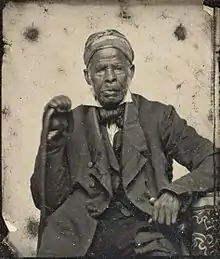
Omar ibn Said, a Senegalese Islamic scholar enslaved in North Carolina for more than 50 years, circa 1850
- Oenomaus, a Gallic gladiator and one of the leaders of rebellious slaves during the Third Servile War.
- Olaudah Equiano (c. 1745–1797), also known as Gustavus Vassa, a prominent African-British author and figure in the abolitionist cause whose birthplace is heavily contested.
- Omar ibn Said (1770–1864), a writer and Islamic scholar from Senegal who was enslaved and transported to the United States in 1807, where he spent the rest of his life enslaved.
- Onesimus, a slave of Philemon of Colossae who ran away and, having met St. Paul, was converted by him. Paul sent him back to the Christian Philemon with a letter, which is the Epistle to Philemon. Ignatius of Antioch mentions an Onesimus as Bishop of Ephesus in the early 2nd century, but it is not certain that these are the same men.
- Oney Judge (1773–1848), enslaved by the family of Martha Washington, and then by the First Lady herself, Judge worked at Mount Vernon and elsewhere as a personal servant to Martha Washington until she escaped in 1796 to Portsmouth New Hampshire.
- Owen Fitzpen, an English merchant who was taken captive by Barbary pirates in 1620 and subsequently escaped.
- Owen Breedlove, father of Madam C.J. Walker.
P

Portrait of Juan de Pareja by Diego Velázquez (c. 1650)
- Harriet Evans Paine, (c. 1822–1917), Texas enslaved woman and later oral historian and storyteller.
- Pallas (freedman), secretary to the Roman emperor Claudius.
- Juan de Pareja (1606–1670), man enslaved by Spanish artist Diego Velázquez. Velázquez trained him as a painter and freed him in 1650.
- Pasion, an Athenian enslaved man and banker.[38] Late in life, he received the rare honor for a freedman of citizenship.[135]
- Saint Patrick, abducted from Britain, enslaved in Ireland, escaped to Britain, returned to Ireland as a missionary.[136]
- Patsey (born c. 1830), an African-American enslaved person that lived in the mid-1800s in South Carolina.
- Paul Jennings (1799–1874), personal servant enslaved by President James Madison during and after his White House years, bought his freedom in 1845 from Daniel Webster. Noted for publishing the first White House memoir, 1865's A Colored Man's Reminiscences of James Madison.[137]
- Paul Smith, a free black who accused the Cherokee headman Doublehead of kidnapping him and forcing him into bondage.[138]
- Peggy Margaret Titsworth, enslaved at 13 years for three years, after a Creek raid in 1794 on her Tennessee home.[129][139]
- Pete and Hannah Byrne, freed enslaved people of the Napoleon Bonaparte Byrne family which traveled from Missouri to California overland (a six-month journey) in 1859, leaving the farm in Missouri and bringing six adults (including Pete & Hannah), the four Byrne children and a herd of cattle and settling in Berkeley, California. Pete and Hannah are considered the first blacks living in Berkeley and among the first African-Americans in California.[140][141]
- Peter Salem (c. 1750–1816), African American born into slavery in Massachusetts, served as a soldier in the American Revolutionary War
- Petronia Justa, a woman in Herculaneum who sued her master claiming to have been born after her mother's emanicipation; the records of the lawsuit were preserved by the eruption of Vesuvius.[142]
- Phaedo of Elis, captured in war, enslaved in Athens and forced into prostitution,[143] became a pupil of Socrates who had him freed, gave his name to one of Plato's dialogues, Phaedo and became a famous philosopher in his own right.
- Phaedrus (c. 15 BCE – c. 50 CE), Roman fabulist.
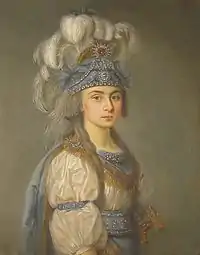
Praskovia Kovalyova-Zhemchugova in a scenic costume for Les mariages samnites by André Ernest Modeste Grétry
- Phillis, a Massachusetts woman enslaved by Captain John Codman. Convicted in the successful plot to poison her master as she and her fellow enslaved "found the rigid discipline of their master unendurable",[124] Phillis was burned to death in 1755.
- Phillis Wheatley (1753–1784?), Colonial American poet, the second published African-American poet and first published African-American woman.
- Phoebe, an enslaved woman who sued for her freedom in Tennessee, along with her sons Davy and Tom, claiming to be the descendants of an enslaved Indian woman whose sister and other relatives had proven that they were wrongly enslaved.[144]
- Philocrates, enslaved man of the 2nd-century BCE Roman reformer Gaius Gracchus. He remained at his master's side when Gracchus was fleeing from his enemies, forsaken by everybody else. Arriving at a grove sacred to the Furies, Philocrates first assisted Gracchus in his suicide before taking his own life, though some rumors held that Philocrates was only killed after he refused to let go of his master's body.
- Phormion, an Athenian enslaved man and banker.[38] Late in life, he received the rare honor for a freedman of citizenship.[135]
- Pierre d'Espagnac, sometimes Pierre d'Espagnal (1650–1689) was a French Jesuit missionary, enslaved by the Siamese.
- Maria Guyomar de Pinha (1664–1728), Siamese royal chef of Japanese-Portuguese ancestry.
- Piruz Nahavandi, killer of the Caliph Umar.
- Pope Pius I, the Bishop of Rome from about 140 to about 154, during the reign of the Roman Emperor Antonius Pius. He was the brother of the freedman Hermas and therefore likely to have been a former slave himself, though that is not mentioned explicitly in the scant records of his life.
- Polly, the subject of the 1820 Indiana Supreme Court case Polly v. Lasselle, which resulted in all slaves held within Indiana to be freed.
- Polly Berry, also known as Polly Crockett and Polly Wash, won an 1843 freedom suit in St. Louis, Missouri and also gained the freedom of her daughter Lucy Ann Berry.
- Politoria, the subject of a lead curse tablet in ancient Rome; it was a curse on Clodia Valeria Sophrone, that she should not get Politoria into her power. She appears to have been a slave-courtesan who feared being sent to the brothel.[145]
- Praskovia Kovalyova-Zhemchugova (1768–1803) was a Russian serf actress and soprano opera singer.
- Primus (1700–1791), enslaved by Daniel Fowle of Portsmouth, New Hampshire. Primus operated the press for the New Hampshire Gazette which is the American newspaper in longest continuous print.
- Prince Whipple (1750–1796), enslaved person owned by American General William Whipple
- Prosper, an enslaved person murdered in 1807 in Virgin Islands by his owner Arthur William Hodge, for which Hodge was tried and executed in 1811, the first (and virtually only) such case ever recorded.
- A pregnant Thrall whose name is not preserved, who was fleeing for her life in 11th-century Oslo, was given refuge on the boat of Hallvard Vebjørnsson, who tried to shield her but was killed together with her by the attackers' arrows, for which he was canonised and became the patron saint of Oslo.[146]
- Publilius Syrus (fl. 85 – 43 BCE), a Latin writer best known for his sententiae. He was a Syrian who was brought as a slave to Italy.
Q
- Quamina Gladstone, father of Jack Gladstone and implicated in the Demerara rebellion of 1823.
- Quock Walker, also known as Kwaku or Quok Walker, sued for and won his freedom in 1781 in a case citing language in the new Massachusetts Constitution (1780) that declared all men to be born free and equal.
- Qutb-ud-din Aybak or Qutbuddin Aibak (1150–1210), Turkish ex-slave, became a soldier, the first of the Sultans of Delhi, founder of India's "slave dynasty".
R
- Rachel, the subject of the 1834 Rachel v. Walker case in the Supreme Court of Missouri which ruled that a U.S. Army officer forfeited his slave if he took the person to territory where slavery is prohibited.[147] This ruling was cited as precedent in 1856 in the Dred Scott v. Sandford case before the Supreme Court of the United States.
- Rachel of Kittery, Maine (died 1695), enslaved woman murdered by her master whose case set a legal precedent in New England.
- Rachel Knight (died 1889), originally a slave owned by the grandfather of Newton Knight, the well-known Southern Unionist who during the American Civil War defied the Confederacy in the rebellion known as the Free State of Jones. After the war, Rachel was emancipated along with the other slaves. By the mid-1870s, Knight had separated from his wife, Serena, and married Rachel. In this period, Knight's grown son, Mat (from his first wife), married Rachel's grown daughter, Fannie, from a previous union. Knight's daughter, Molly, married Rachel's son, Jeff, making three interracial families in the community. Newton and Rachel Knight had several children before her death in 1889.
- Rebecca Huger, an enslaved woman who was freed by General Benjamin F. Butler in New Orleans, and described in a Harper's Weekly article as being to all appearance white, and having come to a school for emancipated slaves in Philadelphia.[40]
- Redoshi (c. 1848 – 1937), the next-to-last surviving victim in the United States of the Transatlantic slave trade
- Remigio Herrera (c. 1810s – 1905), a Cuban enslaved person who became a revered priest in Regla.
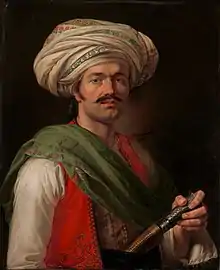
Portrait of Roustam Raza, the mamluck of Napoleon by Horace Vernet (1810)
- Juana Ramírez (1790–1856), rebel soldier and heroine of the Venezuelan War of Independence.
- Pleasant Richardson was an escaped enslaved person who became a Union soldier and property owner in Fincastle, Virginia.
- Robert Blake, earned the Medal of Honor as a sailor during the American Civil War, after becoming a "contraband" (i.e. a slave freed by Unionist forces) and enlisting.
- Robert Drury (1687 – between 1743 and 1750), an English sailor who was shipwrecked on the island of Madagascar in 1702, and remained enslaved there until 1717.
- Robert Smalls (1839–1915), stole a Confederate ship and led a boatload of enslaved people to freedom, causing the Union to allow blacks to enlist; later served as a member of the U.S. House of Representatives for South Carolina's 5th congressional district.
- Robin and Polly Holmes, the plaintiffs in the 1853 Holmes v. Ford court case in the Oregon Territory that freed their children. The decision re-affirmed that slavery was illegal in the territory as outlined in the Organic Laws of Oregon that were continued once the region became a U.S. territory.
- Rosina Downs, an enslaved woman who was freed by General Benjamin F. Butler in New Orleans, and described in a Harper's Weekly article as being to all appearance white, and having come to a school for emancipated slaves in Philadelphia.[40]
- Roustam Raza (1783–1845), Napoleon Bonaparte's Armenian bodyguard.
- Samson Rowlie, Chief Eunuch and Treasurer of Algiers.
- Roxelana see Hürrem Sultan
S
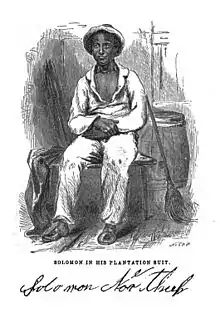
Solomon Northup from Twelve Years a Slave
- Sabuktigin (c. 942 – 997), full name Abu Mansur Sabuktigin, captured and sold into slavery at a young age, rose to become a general and eventually a king and the founder of the Ghaznavid Empire in Medieval Iran.
- Safiye Sultan (c. 1550 – c. 1619), an enslaved Venetian woman who was placed in the harem of the Ottoman Sultan Murad III and became the mother of Sultan Mehmed III.
- Salem Poor (1747–1802), an African-American enslaved man who purchased his freedom, and a war hero during the American Revolutionary War.
- Sally Hemings (1773–1835), a mixed-race woman enslaved by Thomas Jefferson believed by many to have had six children with him, four of whom survived to adulthood.
- Sally Miller or Salomé Müller (born c. 1814), an American enslaved woman whose freedom suit in Louisiana was based on her claimed status as a free German immigrant and indentured servant.[148]
- Sally Seymour (died 1824), American pastry chef and restaurateur, an enslaved woman who was manumitted and became a slave owner herself.
- Salonia the second wife of Cato the Elder
- Salvius, also known as Tryphon, leader of the 104 BCE slave rebellion in Sicily known as the Second Servile War.
- Sambo, a black captive of Tiger King, a Lower Creek, who told the traveler William Bartram that Sambo was his family property.[149]
- Samuel Green (c. 1802 – 1877), an enslaved man who bought his freedom and freedom for his loved ones, was involved with the Underground Railroad, and was jailed in 1857 for carrying a copy of Uncle Tom's Cabin.
- Sandy Jenkins, an enslaved person who Frederick Douglass mentioned in his first autobiography.
- Sara Forbes Bonetta (1843–1880), an Egbado princess of the Yoruba who was orphaned in intertribal warfare, sold into slavery as a child, was rescued by Captain Frederick E. Forbes of the Royal Navy and taken to the United Kingdom where she became a goddaughter to Queen Victoria.
- Satrelanus, from Gaul, sold by Ermedruda to Toto in Milan in 725.[150]
- Scipio Africanus (c. 1702 – 1720).
- Scipio Moorhead, enslaved artist.
- Scipio Vaughan (c. 1784 – c. 1840), was captured from his homeland in Africa at a young age and sold into slavery in the United States. He became a skilled artisan in Camden, South Carolina; gained his freedom and inspired a movement among some of his descendants.
- Servius Tullius, ancient King of Rome said to have started life as a slave (though this was disputed, among both Romans and modern historians).
- Seymour Burr (1754/1762–1837), fought for the Continental Army in the American Revolution.
- Shaghab (died 933), mother and co-ruler of the eighteenth Abbasid Caliph al-Muqtadir.
- Sojourner Truth (c. 1797 – 1883), an abolitionist and women's rights activist.
- Solomon Bayley (1771–1839), wrote a book in 1825 about his life as a slave.
- Solomon Northup (1807 – c. 1863),[151][152] a farmer, professional violinist, and free-born black man from New York who was lured to Washington, D.C., where slavery was legal, kidnapped, and sold in the South. He remained enslaved in Louisiana from 1841 until he was rescued and liberated in 1853. Author of Twelve Years a Slave.
- Solomon Flores, slave from northern Alabama.
- Sosias the Thracian, an Athenian enslaved man, and later freedman, of Nicias, who later leased him a thousand enslaved people for his mining operation.[38]
- Spartacus (c. 111 – 71 BCE), a gladiator and rebel leader during the Servile Revolt.
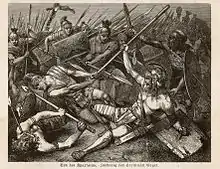
The Death of Spartacus by Hermann Vogel (1882)
- Spendius a Campanian escaped enslaved man who served as a Carthaginian mercenary during the First Punic War and then as a general in the Mercenary War against Carthage.[153]
- Stephen Bishop (c. 1821 – 1857), a mixed-race enslaved man in Kentucky known for being one of the first explorers and guides of Mammoth Cave.
- Sue, a black woman enslaved by James Brown, who was captured along with several members of the Brown family and other slaves by Chickamaugas. When the warrior who had captured her threatened another captive, the other captor threatened to kill Sue in retribution.[154] James' son Joseph later kidnapped Sue and her children and grandchildren—eight in all—in retribution for his captivity.[155]
- Suhayb ar-Rumi (born c. 587), also known as Suhayb ibn Sinan, enslaved in childhood in the Byzantine Empire, escaped as a young man to Mecca and went on to become an esteemed companion of Muhammad and revered member of the early Muslim community.
- Sumayyah bint Khayyat (550–615), a woman enslaved in Mecca and one of the first seven converts to Islam made by the Prophet Muhammad in his early career. She was tortured and killed by the new faith's enemies, becoming the first Muslim Shahid.
- Squanto (1585–1622), also known as Tisquantum, a Native American of what is now coastal Massachusetts who was captured by English pirates and sold as a slave. He was later freed and returned to New England, where he met the Pilgrims of the Mayflower in 1621.
- Subh of Cordoba (940–999), an enslaved concubine of a Caliph and mother and regent of the next Caliph of Cordoba in the 10th century.
- Suk-bin Choe (1670–1718), consort of Sukjong of Joseon and mother of Yeongjo of Joseon.
T

Alleged portrait of Terence, from Codex Vaticanus Latinus 3868. Possibly copied from 3rd-century original.
- Taras Shevchenko (1814–1861): The most prominent Ukrainian poet, artist and illustrator was born in a family of serfs. His artist friends bought his freedom in 1838.
- Tatyana Shlykova (1773–1863), Russian serf ballerina and opera singer.
- Thomas Peters (1738–1792), born Thomas Potters, one of the founding fathers of Sierra Leone. A former slave who fled North Carolina during the American Revolutionary War, Peters was a Black Loyalist member of the British Black Company of Pioneers, became a sergeant, and settled and married in Nova Scotia. He recruited African settlers in Nova Scotia for the colonization of Sierra Leone and later became a leader in Freetown.
- Thomas Sims (born 1834), an enslaved African American man who escaped slavery in Georgia to Boston, Massachusetts, only to be recaptured under the Fugitive Slave Act of 1850 and to escape to Boston once more.
- Thomas-Alexandre Dumas (25 March 1762 – 26 February 1806), a French general and father of Alexandre Dumas.
- Thumal, administrator of justice to the eighteenth Abbasid Caliph al-Muqtadir.
- T. Aelius Dionysius, a freedman of the late Roman Empire, who created a stela for himself, his wife, and Aelius Perseus, his fellow freedman, and their freedman and those who came after them.[156]
- T. Claudius Dionysius, a freedman whose freedwoman wife Claudia Prepontis erected a funerary altar to him. Their clasped hands, depicted on it, show the legitimacy of their marriage, possible only once they obtained their freedom.[41]
- Terence (c. 195/185 – c. 159 BCE), full name Publius Terentius Afer, Roman playwright and comic poet who wrote before and possibly after his freedom.
- Tiberius Claudius Narcissus, freed enslaved man who was secretary to the Roman emperor Claudius in the 1st century.
- Tituba, a 17th-century Native American enslaved woman who was enslaved by Samuel Parris of Danvers, Massachusetts. She was the first person accused of practicing witchcraft during the 1692 Salem witch trials.[157]
- Tomás Ortega, an enslaved man in colonial Mexico who attempted to marry Leonor de Mendoza, an enslaved woman of another master. When her master imprisoned Tomás, Leonor appealed to a church court for assistance, and it threatened excommunication for the master if he did not free Tomás.[105]
- Titus Kent (1733–18??), lived as enslaved individual with Samuel Kent family in Suffield Connecticut. He was owned by Samuel Kent, who lived 1698–1772; Samuel Kent's 1772 probate recorded that Titus was bequeathed Samuel Kent's son, Elihu Kent. Revolutionary War records indicate that Titus served in different regiments from 1775–1783.
- Toussaint L'Ouverture (1743–1803), a freed enslaved man who led the slave revolt that led to the independence of Haiti.
- Tula (died 1795), a leader of the Curaçao Slave Revolt of 1795.
- Turgut Reis (1485–1565), also known as Dragut, a well-known admiral of the Ottoman Navy of the 16th century who was captured by the Genoese at Corsica and forced to work as a galley slave for nearly four years. He was finally rescued by his fellow admiral Barbarossa, who laid siege to Genoa and secured Turgut Reis' release for the prodigious ransom of 3,500 gold ducats. Thereupon, Turgut Reis resumed his naval career (which included the enslavement of various other people).
- Turhan Hatice Sultan (c. 1627 – 4 August 1683) was Haseki Sultan of the Ottoman Sultan Ibrahim (reign 1640–48) and Valide Sultan as the mother of Mehmed IV (reign 1648–87).
U
- Ukawsaw Gronniosaw (1705–1775), also known as James Albert, a freed enslaved man turned writer whose autobiography is considered the first published by an African in Britain.
V
- Vasily Tropinin (1776–1857), Russian serf painter.
- Venture Smith (1729–1805), an African captured as a child and transported to the American colonies as a slave. When an adult, he purchased his freedom and that of his family – his wife Meg and their children Hannah, Solomon and Cuff. His history was documented and published by a schoolteacher, to whom he talked in his old age.
- The Vestmenn ("West Men" in Old Norse, referring to the Irish) were a group of Irish slaves brought to Iceland by Hjörleifr Hróðmarsson, one of the early Norse settlers there. He treated them badly, and they killed him and escaped to a group of offshore islands. Ingólfur Arnarson, Hjörleifur's blood brother, tracked the escaped slaves and killed them all. Though their individual names are unknown, their memory lives on in Icelandic geography, the islands where they sought refuge being known up to the present as "Vestmannaeyjar": "Islands of the West Men" (i.e. of the Irish).
- Vincent de Paul (1581–1660), a French priest who is venerated as a saint in the Catholic Church. He was taken captive by Turkish pirates, sold into slavery, and freed in 1607.[158]
- Vindicius, an ancient Roman slave who discovered Tarquin's plot to regain power.
- Vibia Calybeni, a freedwoman of the late Roman Empire who unusually named herself as a madam on her tombstone.[159]
- Virginia Boyd, an American enslaved woman whose letter to R.C. Ballard, pleading not to be sold with her children among strangers, has been preserved. Ballard had undertaken to have her sold at the request of Judge Samuel Boyd, the children's father, to hide her existence from his family.
- Violet Ludlow, an American woman sold as a slave several times despite her claims to be a free white woman.[40]
- Vitalis, ancient Roman enslaved person. The epigraph of the slave boy Iucundus describes him as the son of Gryphus and Vitalis.[67]
- Volumnia Cytheris, an enslaved and later freedwoman in ancient Rome. An actress and courtesan, her lovers included Brutus, Mark Antony, and Cornelius Gallus; her rejection of Gallus provided the theme for Virgil's tenth Eclogue.[160]
W
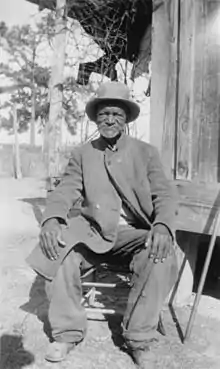
Photograph of Wes Brady, ex-slave, taken in Marshall, Texas, in 1937 as part of the Federal Writers' Project Slave Narrative Collection
- Wes Brady (born 1849), of Marshall, Texas, was included in the Federal Writers' Project Slave Narrative Collection.
- William Ansah Sessarakoo (c. 1736–1770), African prince who became a victim of the transatlanic slave trade, was freed, and then became a slave trader himself.
- William Beverly Nash (1822–1888), a North Carolina state senator.
- William Ellison (1790–1861), an enslaved man of mixed race who, after gaining his freedom, became a slaveholder himself, producing cotton.
- William Gardner (born 1759), a man enslaved by James Madison who Madison sold into indentured servitude for seven years before becoming emancipated and working as a merchant's agent.
- William (1824–1900) and Ellen Craft (1826–1891), a married slave couple from Macon, Georgia, whose daring escape to the North in 1848 made them among the most famous fugitive slaves in the country.
- William Harvey Carney (1840–1908), a soldier during the American Civil War who received the Medal of Honor after his escape from slavery.
- William Henry, nicknamed "Jerry", an enslaved man who escaped from Missouri but was arrested in Syracuse, New York in 1851 before being rescued by abolitionists from being extradited under the Fugitive Slave Law.
- William A. Jackson, man enslaved by Jefferson Davis who fled in 1861 with considerable detailed military intelligence about Confederate forces.
- William D. Gibbons (1825–1886), enslaved domedtic setvant; became AfricanBaptist minister after emancipation.
- William Lee (1750–1828), a man enslaved by George Washington who served as his personal servant with him during the American Revolutionary War and was the only enslaved person freed via Washington's will.
- William Okeley Englishman enslaved by Algerian pirates.
- Wulfstan, an enslaved man in Anglo-Saxon England, and his two sons and stepdaughter. They were freed by his mistress Æthelgifu's will.[52]
- Wu Rui (吳瑞), a 15th-century enslaved eunuch in what is now Vietnam. He was the youngest of thirteen Chinese men from Wenchang whose ship was blown off course and who were subsequently enslaved by the Lê dynasty. As recorded in the Ming Shi-lu, his companions were made agricultural laborers while Wu Rui was castrated and became an attendant at the Imperial Citadel of Thang Long. After years of service, he was promoted at the death of the Vietnamese ruler in 1497 to a military position in northern Vietnam. A soldier told him of an escape route back to China and Wu Rui escaped to Longzhou. The local chief planned to sell him back to the Vietnamese, but Wu was rescued by the Pingxiang magistrate and then was sent to Beijing to work as a eunuch in the palace.
- Wyatt Lee (c. 1822–1863), the first husband of Dr. Rebecca Davis Lee Crumpler. He escaped slavery in Virginia.
X
- Xenon, an Athenian enslaved man and banker.[38]
Y
- Yaqut al-Hamawi (1179–1229), an Arab biographer and geographer known for his encyclopedic writings on the Muslim world. He was sold into slavery in 12th-century Syria and taken to Baghdad, but was provided with a good education by an enlightened owner and later freed.
- Yasār, a 7th-century Christian man who had been captured in a campaign of Khalid ibn al-Walid, a companion of the Prophet Muhammad. Yasār was taken to Medina and became the slave of Qays ibn Makhrama ibn al-Muṭṭalib ibn ʿAbd Manāf ibn Quṣayy. He accepted Islam, was manumitted and became his mawlā, thus acquiring the nisbat al-Muṭṭalibī. He had three sons – Mūsā, ʿAbd al-Raḥmān, and Isḥāq. His grandson, Ibn Ishaq, became an important early Arab historian.
- York (1770–before 1832), an African-American man enslaved by William Clark who accompanied the Lewis and Clark Expedition.
Z
- Zalmoxis, a Dacian who was enslaved by Pythagoras on the island of Samos, according to Herodotus. Zalmoxis learned philosophy from his master and other wise Greeks. Eventually he was liberated, gathered huge wealth and went back to his homeland, where he converted the Thracians to his beliefs, was greatly venerated for his wisdom and in later generations became worshiped as a god.[161]
- Zayd ibn Haritha (c. 581–629), given to Muhammad's wife Khadijah, freed, adopted, and became known as Zayd ibn Muhammad.
- Ziryab (789–857), also known as Abul-Hasan Alí Ibn Nafí, a Muslim singer, musician, and polymath known for introducing the crop asparagus to Europe.
- Zoe, a Christian martyr
- Zofia Potocka (1760–1822), a Greek-Ottoman enslaved courtesan who ended up as a Polish countess by marriage.
- Zumbi (1655–1695), an enslaved person in Portuguese Brazil who escaped and joined the Quilombo dos Palmares, the largest ever settlement of escaped slaves in colonial Brazil, becoming its last and most famous leader.
See also
- List of the last surviving American slaves
- List of slave owners
- Timeline of abolition of slavery and serfdom
- 1926 Slavery Convention, an international treaty
- 1956 Supplementary Convention on the Abolition of Slavery
- Comfort women, sex slaves in WWII
- Human trafficking
- Involuntary servitude
- International Slavery Museum
- U.S. National Museum of African American History and Culture
- Slave trade
- Slave Trade Acts
- Slavery
- Slavery in the colonial history of the United States
- Slavery in the United States
- United States National Slavery Museum
References
- Christina Snyder, Slavery in Indian Country: The Changing Face of Captivity in Early America, p. 141, ISBN 978-0-674-04890-4
- Christine Fell, Women in Anglo-Saxon England: and the Impact of 1066, p. 49, ISBN 0-7141-8057-2
- Charter S 1539 at the Electronic Sawyer
- Elaine Fantham, Helene Peet Foley, Natalie Boymel Kampen, Sarah B. Pomeroy, H. A. Shapiro, Women in the Classical World p. 370, ISBN 0-19-509862-5
- Fell, Women in Anglo-Saxon England, p. 97
- Rypka, J. (November 11, 2013). History of Iranian Literature. ISBN 9789401034791.
- "St. Agathoclia", Catholic Saints
- Gross (2008), What Blood Won't Tell, p. 1
- "A Durable Memento:" Portraits by Augustus Washington, African American Daguerreotypist, exhibit, National Portrait Gallery, Smithsonian Institution
- Letter to James Edward Calhoun, August 27, 1831, Correspondence of John C. Calhoun, Historical Manuscripts Commission (1899), p. 301.
- Letter to Armistead Burt of September 1, 1831, Correspondence of John C. Calhoun, Historical Manuscripts Commission (1899), pp. 301–02.
- Calhoun 1837, p. 34.
- Snyder, Slavery in Indian Country, p. 39
- Snyder, Slavery in Indian Country, pp. 201–202
- Snyder, Slavery in Indian Country, pp. 140–1
- Timothy Hugh Barrett (1989). Singular listlessness: a short history of Chinese books and British scholars. Wellsweep. p. 33. ISBN 0-948454-04-0. Retrieved November 4, 2011.
This man, who as far as we know was the first interpreter to try to impart a knowledge of Chinese to Englishman, was one of a number of black slaves from Macao who managed to escape into Chinese territory2. Presumably Antonio and Mundy
(the University of Michigan) - Ariela J. Gross (2008), What Blood Won't Tell: A History of Race on Trial in America, p. 31, ISBN 978-0-674-03130-2
- "Who was Aqualtune?
- Maria Aparecida Schumaher, Erico teixeira Vital Brazil, Dicionário Mulheres do Brasil: de 1500 até a atualidade, ISBN 9788571105737
- ""Augustine Tolton: From slavery to being the first black priest", Catholic Church
- Fantham, et al.,Women in the Classical World pp. 319–20
-
 This article incorporates text from a publication now in the public domain: Fournet, Pierre August (1907). "St. Bathilde". In Herbermann, Charles (ed.). Catholic Encyclopedia. 2. New York: Robert Appleton Company.
This article incorporates text from a publication now in the public domain: Fournet, Pierre August (1907). "St. Bathilde". In Herbermann, Charles (ed.). Catholic Encyclopedia. 2. New York: Robert Appleton Company. - Snyder, Slavery in Indian Country, p. 185
- Snyder, Slavery in Indian Country, p 168
- Fantham et al., Women in the Classical World, p. 268
-
 This article incorporates text from a publication now in the public domain: Kirsch, Johan Peter (1907). "St. Blandina". In Herbermann, Charles (ed.). Catholic Encyclopedia. 2. New York: Robert Appleton Company.
This article incorporates text from a publication now in the public domain: Kirsch, Johan Peter (1907). "St. Blandina". In Herbermann, Charles (ed.). Catholic Encyclopedia. 2. New York: Robert Appleton Company. - British Library Add MS 9381.
- Jones, Heather Rose (2001). "Cornish (and Other) Personal Names from the 10th Century Bodmin Manumissions". Retrieved May 18, 2017.
- "Gospel-book with added Cornish records of manumissions ('The Bodmin Gospels' or 'St Petroc Gospels')". The British Library. Retrieved May 18, 2017.
- Joyce, P. W., The Wonders of Ireland, 1911
- "Story of St. Brigid". St. Brigid's GNS, Glasnevin.
- "Following Brigid's Way – The Irish Catholic".
- "Bethu Brigte".
- Wallace, Martin. A Little Book of Celtic Saints. Belfast. Appletree Press, 1995, ISBN 0-86281-456-1, p.13
- "St Brigit of Ireland – Monastic Matrix".
- Williams, Emily Allen (2004). The Critical Response to Kamau Brathwaite. Praeger Publishers. p. 235. ISBN 0-275-97957-1.
-
 This article incorporates text from a publication now in the public domain: Chapman, Henry Palmer (1908). "Pope Callistus I". In Herbermann, Charles (ed.). Catholic Encyclopedia. 3. New York: Robert Appleton Company.
This article incorporates text from a publication now in the public domain: Chapman, Henry Palmer (1908). "Pope Callistus I". In Herbermann, Charles (ed.). Catholic Encyclopedia. 3. New York: Robert Appleton Company. - Yvon Garlan, Slavery in Ancient Greece, p. 67, ISBN 0-8014-9504-0
- Karen Halttunen, Murder Most Foul, p. 175, ISBN 0-674-58855-X
- Tenzer, Lawrence R. (October 2001). "White Slaves". The Multiracial Activist. Archived from the original on November 9, 2011.
- Elaine Fantham, Helene Peet Foley, Natalie Boymel Kampen, Sarah B. Pomeroy, H. A. Shapiro, Women in the Classical World pp. 320–1, ISBN 0-19-509862-5
- Grieve, Alexander James; Robinson, Joseph Armitage (1911). . In Chisholm, Hugh (ed.). Encyclopædia Britannica. 6 (11th ed.). Cambridge University Press. pp. 482–483.
- Snyder, Slavery in Indian Country, p. 196
- David Granger (1992). "Guyana coins". El Dorado (2): 20–22. Archived from the original on June 26, 2008. Retrieved July 6, 2008.
- Elaine Fantham, Helene Peet Foley, Natalie Boymel Kampen, Sarah B. Pomeroy, H. A. Shapiro, Women in the Classical World p. 268, ISBN 0-19-509862-5
- Christina Snyder, Slavery in Indian Country: The Changing Face of Captivity in Early America, p. 133, ISBN 978-0-674-04890-4
- "Exhibit: Slavery in New York". New York Historical Society. October 7, 2006 – March 26, 2006. Retrieved February 11, 2008.
- http://library.uncg.edu/slavery/
- Kaufmann, Miranda. "The Untold Story of How an Escaped Slave Helped Sir Francis Drake Circumnavigate the Globe". History. Retrieved May 12, 2020.
- see
- .
- Christine Fell, Women in Anglo-Saxon England: and the Impact of 1066, p. 97, ISBN 0-7141-8057-2
- Christina Snyder, Slavery in Indian Country: The Changing Face of Captivity in Early America, p. 197, ISBN 978-0-674-04890-4
- Christine Fell, Women in Anglo-Saxon England: and the impact of 1066, p. 86, ISBN 0-7141-8057-2
- The Fiddler on Pantico Run: An African Warrior, His White Descendants, A Search for Family, ISBN 978-1-4516-2748-0
- Christina Snyder, Slavery in Indian Country: The Changing Face of Captivity in Early America, p. 130, ISBN 978-0-674-04890-4
- Daniel K. Richter, Facing East from Indian Country, p. 243, ISBN 0-674-00638-0
- Elaine Fantham, Helene Peet Foley, Natalie Boymel Kampen, Sarah B. Pomeroy, H. A. Shapiro, Women in the Classical World p. 270, ISBN 0-19-509862-5
- Catholic Online
- E. Togo Salmon Conference, E. Togo Salmon Conference 1993 Mcmaster University: Roman Theater and Society: E. Togo Salmon Papers I
-
 This article incorporates text from a publication now in the public domain: Kirsch, Johan Peter (1909). "Sts. Felicitas and Perpetua". In Herbermann, Charles (ed.). Catholic Encyclopedia. 6. New York: Robert Appleton Company.
This article incorporates text from a publication now in the public domain: Kirsch, Johan Peter (1909). "Sts. Felicitas and Perpetua". In Herbermann, Charles (ed.). Catholic Encyclopedia. 6. New York: Robert Appleton Company. - Afnan, Abul-Qasim (1999), Black Pearls: Servants in the Household of the Bab and Baha'u'llah, Kalimat Press, p. 21, ISBN 1-890688-03-7
- Afnan, Abul-Qasim (1999), Black Pearls: Servants in the Household of the Bab and Baha'u'llah, Kalimat Press, p. 26, ISBN 1-890688-03-7
- Christina Snyder, Slavery in Indian Country: The Changing Face of Captivity in Early America, pp. 147–8, ISBN 978-0-674-04890-4
- Daniel Odgen, Magic, Witchcraft, and Ghosts In The Greek and Roman Worlds, p. 277, ISBN 978-0-19-538520-5
- Goodyear III, Frank H. "Photography changes the way we record and respond to social issues". Smithsonian Institution
- Daniel Odgen, Magic, Witchcraft, and Ghosts In The Greek and Roman Worlds, p. 119, ISBN 978-0-19-538520-5
- See also Ariela J. Gross, What Blood Won't Tell: A History of Race on Trial in America, pp. 23–4, ISBN 978-0-674-03130-2
- See also Robert M. Cover, Justice Accused: Antislavery and the Judicial Process, New Haven and London: Yale University Press, 1975, pp. 51–55
- Bosman, Julie (September 18, 2013). "Professor Says He Has Solved a Mystery Over a Slave's Novel". The New York Times.
- Black Loyalist.
- BlackPast.org.
- Lowson, Stephen (May 29, 2009). "Day of history to unfold in Muthill museum". Strathearn Herald. Retrieved June 23, 2009.
- Christina Snyder, Slavery in Indian Country: The Changing Face of Captivity in Early America, pp. 38–9, ISBN 978-0-674-04890-4
- Chris Wickham, The Inheritance of Rome, p. 195, ISBN 978-0-14-311742-1
- Laurence Vidal, Los Amantes de Granada, Ed. EDHASA, 2006, 359 pages, (ISBN 978-8-43501742-8)
- Afnan, Abul-Qasim (1999), Black Pearls: Servants in the Household of the Bab and Baha'u'llah, Kalimat Press, p. 27, ISBN 1-890688-03-7
- Afnan, Abul-Qasim (1999), Black Pearls: Servants in the Household of the Bab and Baha'u'llah, Kalimat Press, p. 30, ISBN 1-890688-03-7
- 'Abdu'l-Baha (1982). Promulgation of Universal Peace: Talks Delivered by Abdu'l Baha during His Visit to the United States and Canada in 1912. Bahai Publishing Trust, 2nd Edition. p. 426. ISBN 978-0877431725.
- Ariela J. Gross, What Blood Won't Tell: A History of Race on Trial in America, pp. 24–5, ISBN 978-0-674-03130-2/
- "An Old Actor's Memories; What Mt. Edmon S. Conner Recalls About His Career" (PDF). The New York Times. June 5, 1881. p. 10. Retrieved March 10, 2010.
- Hutton, Michael (June–December 1889). "The Negro on the Stage". Harper's Magazine. Harper's Magazine Co. 79: 131–145. Retrieved March 10, 2010.
- Mary Deborah Petite, "1836 Facts about the Alamo and the Texas War for Independence", ISBN 978-1-882810-35-2, Savas Publishing Company, Mason City, IA, 1999, p. 128
- Karen Halttunen, Murder Most Foul, p. 44, ISBN 0-674-58855-X.
- John Donoghue (2010). "'Out of the Land of Bondage': The English Revolution and the Atlantic Origins of Abolition". The American Historical Review. 115 (4).
- Paul Finkelman (1985). Slavery in the Courtroom: An Annotated Bibliography of American Cases. Library of Congress. ISBN 9781886363489.
- Coates, Rodney D. (2003). "Law and the Cultural Production of Race and Racialized Systems of Oppression" (PDF). American Behavioral Scientist. 47 (3): 329–351. doi:10.1177/0002764203256190. S2CID 146357699.
- Tom Costa (2011). "Runaway Slaves and Servants in Colonial Virginia". Encyclopedia Virginia.
- Paul Finkelman (1985). Slavery in the Courtroom: An Annotated Bibliography of American Cases (Library of Congress), p. 3.
- "Soldier of Furtune: John Smith before Jamestown". Archived from the original on January 17, 2009. Retrieved February 4, 2009.
- Smith 2001, pp. 94–95; White 2016, p. 130.
- Brands 2012, pp. 86–87.
- Smith 2001, pp. 94–95; McFeely 1981, p. 69; White 2016, p. 130.
- Christina Snyder, Slavery in Indian Country: The Changing Face of Captivity in Early America, p. 200, ISBN 978-0-674-04890-4.
- Snyder, Slavery in Indian Country, pp. 184–85.
- Snyder, Slavery in Indian Country, pp. 35–36.
- Snyder, Slavery in Indian Country, p. 201.
- Haley, Alex (August 17, 1976). Roots: The Saga of an American Family. Doubleday. p. 704. ISBN 0-385-03787-2. OCLC 2188350.
- Wright, Donald R. (1981). "Uprooting Kunta Kinte: On the Perils of Relying on Encyclopedic Informants". History in Africa. 8: 205–217. doi:10.2307/3171516. JSTOR 3171516.
- Andrews, William L.; Foster, Frances Smith; Harris, Truder (February 15, 2001). "Kinta, Kunta". In Berger, Roger A. (ed.). The Concise Oxford Companion to African American Literature. Oxford University Press. p. 250. ISBN 9780198031758.
- Snyder, Slavery in Indian Country, p. 67
- Fell, Women in Anglo-Saxon England, p. 47
- Fell, Women in Anglo-Saxon England, p. 86
- Patricia Seed, To Love, Honor, and Obey in Colonial Mexico: Conflicts over Marriage Choice, 1574–1821, p. 82, ISBN 0-8047-2159-9
- Snyder, Slavery in Indian Country, p. 149
- Mark C. Elliott, The Manchu Way p. 330, ISBN 0-8047-4684-2
- "Louis Hughes". American Literature. Retrieved July 3, 2020.
- Daniel Odgen, Magic, Witchcraft, and Ghosts In The Greek and Roman Worlds, p. 166, ISBN 978-0-19-538520-5
- Fantham, et al., Women in the Classical World, pp. 319–20
- Daniel Ogden "Binding Spells" p. 70 Witchcraft and Magic in Europe: Ancient Greece and Rome, edited by Bengt Ankarloo and Stuart Clark ISBN 0-8122-1705-5
- Chris Wickham, The Inheritance of Rome, pp. 203–4, ISBN 978-0-14-311742-1
- Snyder, Slavery in Indian Country, p. 182
- Sarah B. Pomeroy, Goddesses, Whores, Wives, and Slaves, p. 198, ISBN 0-8052-1030-X
- Snyder, Slavery in Indian Country, pp. 174–5
- Military Manpower, Armies and Warfare in South Asia. Routledge. October 6, 2015. ISBN 9781317321279.
- Slavery & South Asian history. Chatterjee, Indrani., Eaton, Richard Maxwell. Bloomington: Indiana University Press. 2006. ISBN 978-0-253-11671-0. OCLC 191950586.CS1 maint: others (link)
- Tourism Potential in Aurangabad: With Ajanta, Ellora, Daulatabad Fort. Bharatiya Kala Prakashan. 1999. p. 6. ISBN 9788186050446.
- Michell, George & Mark Zebrowski. Architecture and Art of the Deccan Sultanates (The New Cambridge History of India Vol. I:7), Cambridge University Press, Cambridge, 1999, ISBN 0-521-56321-6, p. 11–12
- "Slave revolts in Puerto Rico: conspiracies and uprisings, 1795–1873"; by: Guillermo A. Baralt; Publisher Markus Wiener Publishers; ISBN 1-55876-463-1, ISBN 978-1-55876-463-7
- ""My Master Has Sold Albert to a Trader": Maria Perkins Writes to Her Husband, 1852". History Matters. George Mason University. Retrieved April 21, 2017.
- http://clandestine-life.com
- http://www.celebrateboston.com/crime/puritan-mark-and-phillis-executions.htm
- http://www.masshist.org/database/viewer.php?item_id=99&mode=transcript&img_step=2#page2
- Afnan, Abul-Qasim (1999), Black Pearls: Servants in the Household of the Bab and Baha'u'llah, Kalimat Press, p. 35, ISBN 1-890688-03-7
- John, Storms Brewed, p. 699
- Barr, Peace Came in the Form, p. 189
- Christina Snyder, Slavery in Indian Country: The Changing Face of Captivity in Early America, pp. 133–4, ISBN 978-0-674-04890-4
- "Re: Nancy Titsworth-1800-Livin - Genealogy.com". genealogy.com. Retrieved May 13, 2019.
- Afnan, Abul-Qasim (1999), Black Pearls: Servants in the Household of the Bab and Baha'u'llah, Kalimat Press, p. 5, ISBN 1-890688-03-7
- Association of Muslim Social Scientists & International Institute of Islamic Thought 2008, p. 56
- Ariela J. Gross, What Blood Won't Tell: A History of Race on Trial in America, p. 120, ISBN 978-0-674-03130-2
- Elaine Fantham, Helene Peet Foley, Natalie Boymel Kampen, Sarah B. Pomeroy, H. A. Shapiro, Women in the Classical World pp. 114–5, ISBN 0-19-509862-5
- Yvon Garlan, Slavery in Ancient Greece, p. 83, ISBN 0-8014-9504-0
-
 This article incorporates text from a publication now in the public domain: Moran, Patrick Francis (1911). "St. Patrick". In Herbermann, Charles (ed.). Catholic Encyclopedia. 11. New York: Robert Appleton Company.
This article incorporates text from a publication now in the public domain: Moran, Patrick Francis (1911). "St. Patrick". In Herbermann, Charles (ed.). Catholic Encyclopedia. 11. New York: Robert Appleton Company. - Swarns, Rachel L. (August 15, 2009), "Madison and the White House, Through the Memoir of a Slave", The New York Times, retrieved August 24, 2009
- Christina Snyder, Slavery in Indian Country: The Changing Face of Captivity in Early America, p. 189, ISBN 978-0-674-04890-4
- "Re: Nancy Titsworth-1800-Livin - Genealogy.com". genealogy.com. Retrieved May 13, 2019.
- Pettitt, George A. Berkeley: The Town and Gown of It. P. 34, 37.
- Wollenberg, Charles (2002). "Berkeley, A City in History". berkeleypubliclibrary.org. Archived from the original on September 11, 2015. Retrieved November 6, 2015.
Berkeley's black heritage goes back to the arrival of Pete and Hannah Byrne in 1859, but the African American population remained small for the rest of the nineteenth century.
- Sarah B. Pomeroy, Goddesses, Whores, Wives, and Slaves, p. 197, ISBN 0-8052-1030-X
- Diogenes Laërtius, ii. 105
- Ariela J. Gross, What Blood Won't Tell: A History of Race on Trial in America, pp. 25–6, ISBN 978-0-674-03130-2
- Daniel Ogden "Binding Spells" pp 67–8 Witchcraft and Magic in Europe: Ancient Greece and Rome, edited by Bengt Ankarloo and Stuart Clark ISBN 0-8122-1705-5
- Hallvard Den Hellige – utdypning (Store norske leksikon)
- "Timeline of Missouri's African American History", Missouri State Archives, Missouri Digital History, accessed 18 February 2011
- Ariela J. Gross, What Blood Won't Tell: A History of Race on Trial in America, p. 59, ISBN 978-0-674-03130-2
- Christina Snyder, Slavery in Indian Country: The Changing Face of Captivity in Early America, p. 129, ISBN 978-0-674-04890-4
- Chris Wickham, The Inheritance of Rome, p. 204, ISBN 978-0-14-311742-1
- Chisholm, Hugh (1911). "Solomon Northup". Encyclopædia Britannica (11th ed.). Cambridge University Press.
- Nelson, Emmanuel Sampath (2002). "Solomon Northup (1808–1863?)". In Marsden, Elizabeth (ed.). African American Autobiographers: A Sourcebook. Greenwood Publishing Group. p. 290. ISBN 9780313314094.
- Richard Miles, Carthage Must Be Destroyed: The Rise and Fall of an Ancient Civilization, p. 203, ISBN 9780143121299
- Christina Snyder, Slavery in Indian Country: The Changing Face of Captivity in Early America, p. 153, ISBN 978-0-674-04890-4
- Christina Snyder, Slavery in Indian Country: The Changing Face of Captivity in Early America, p. 154, ISBN 978-0-674-04890-4
- Elaine Fantham, Helene Peet Foley, Natalie Boymel Kampen, Sarah B. Pomeroy, H. A. Shapiro, Women in the Classical World pp. 369–70, ISBN 0-19-509862-5
- Breslaw, E.G. (1996). Tituba, Reluctant Witch of Salem Devilish Indians and Puritan Fantasies. New York New York University Press. ISBN 0814713076.
-
 This article incorporates text from a publication now in the public domain: Dégert, Antoine (1912). "St. Vincent de Paul". In Herbermann, Charles (ed.). Catholic Encyclopedia. 15. New York: Robert Appleton Company.
This article incorporates text from a publication now in the public domain: Dégert, Antoine (1912). "St. Vincent de Paul". In Herbermann, Charles (ed.). Catholic Encyclopedia. 15. New York: Robert Appleton Company. - Elaine Fantham, Helene Peet Foley, Natalie Boymel Kampen, Sarah B. Pomeroy, H. A. Shapiro, Women in the Classical World p. 380, ISBN 0-19-509862-5
- Sarah B. Pomeroy, Goddesses, Whores, Wives, and Slaves, pp. 198–9, ISBN 0-8052-1030-X
- Daniel Odgen, Magic, Witchcraft, and Ghosts In The Greek and Roman Worlds, p. 11, ISBN 978-0-19-538520-5
This article is issued from Wikipedia. The text is licensed under Creative Commons - Attribution - Sharealike. Additional terms may apply for the media files.
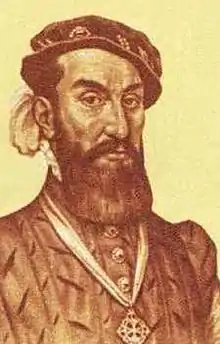
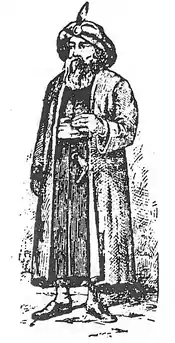

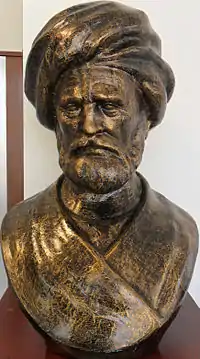
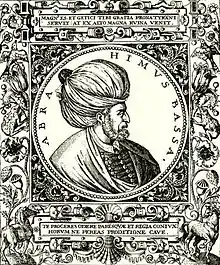
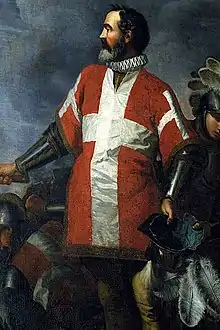
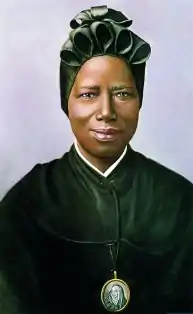
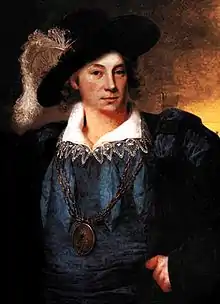

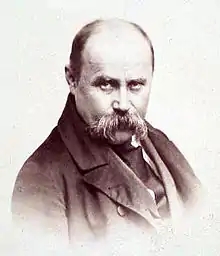
.jpg.webp)

